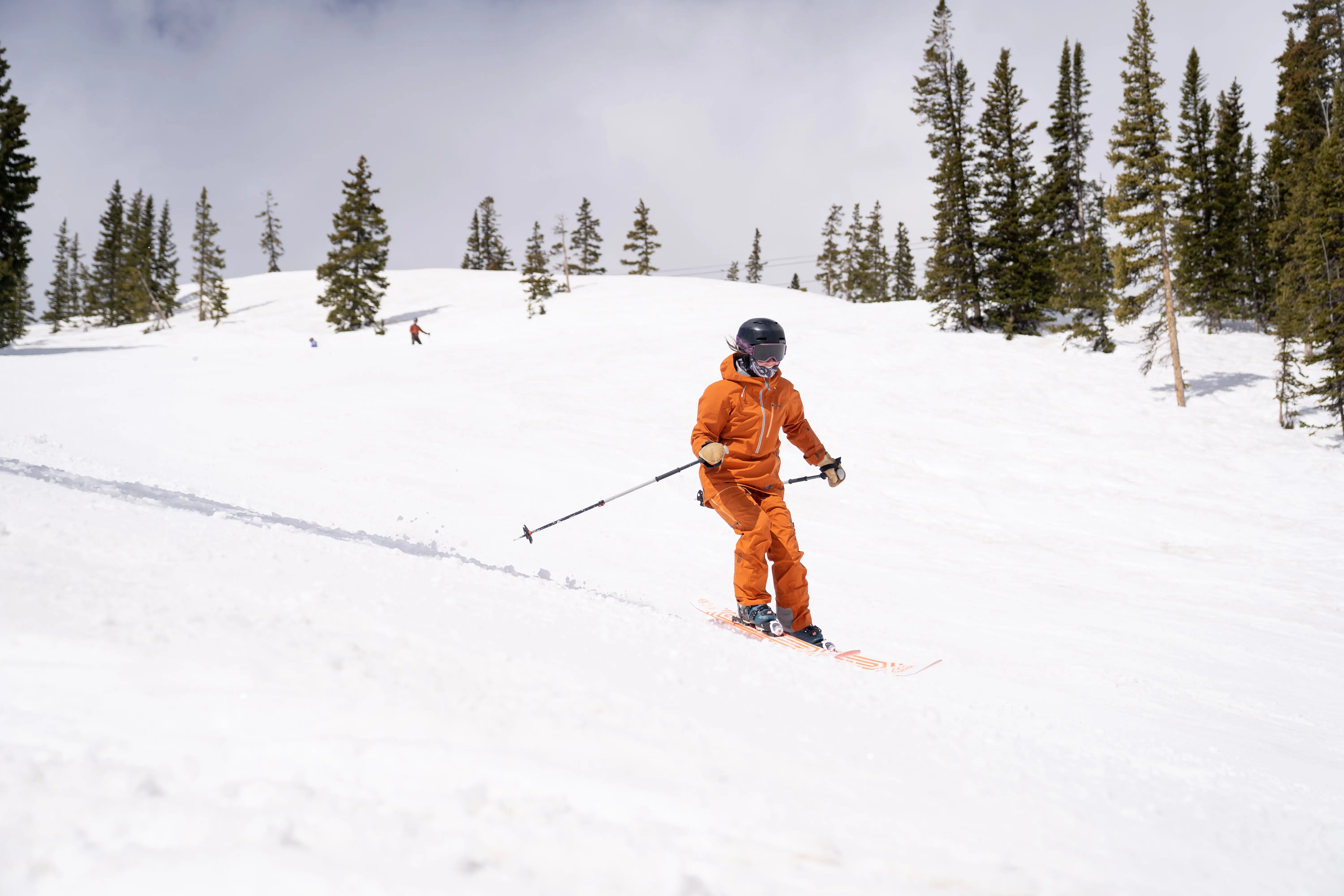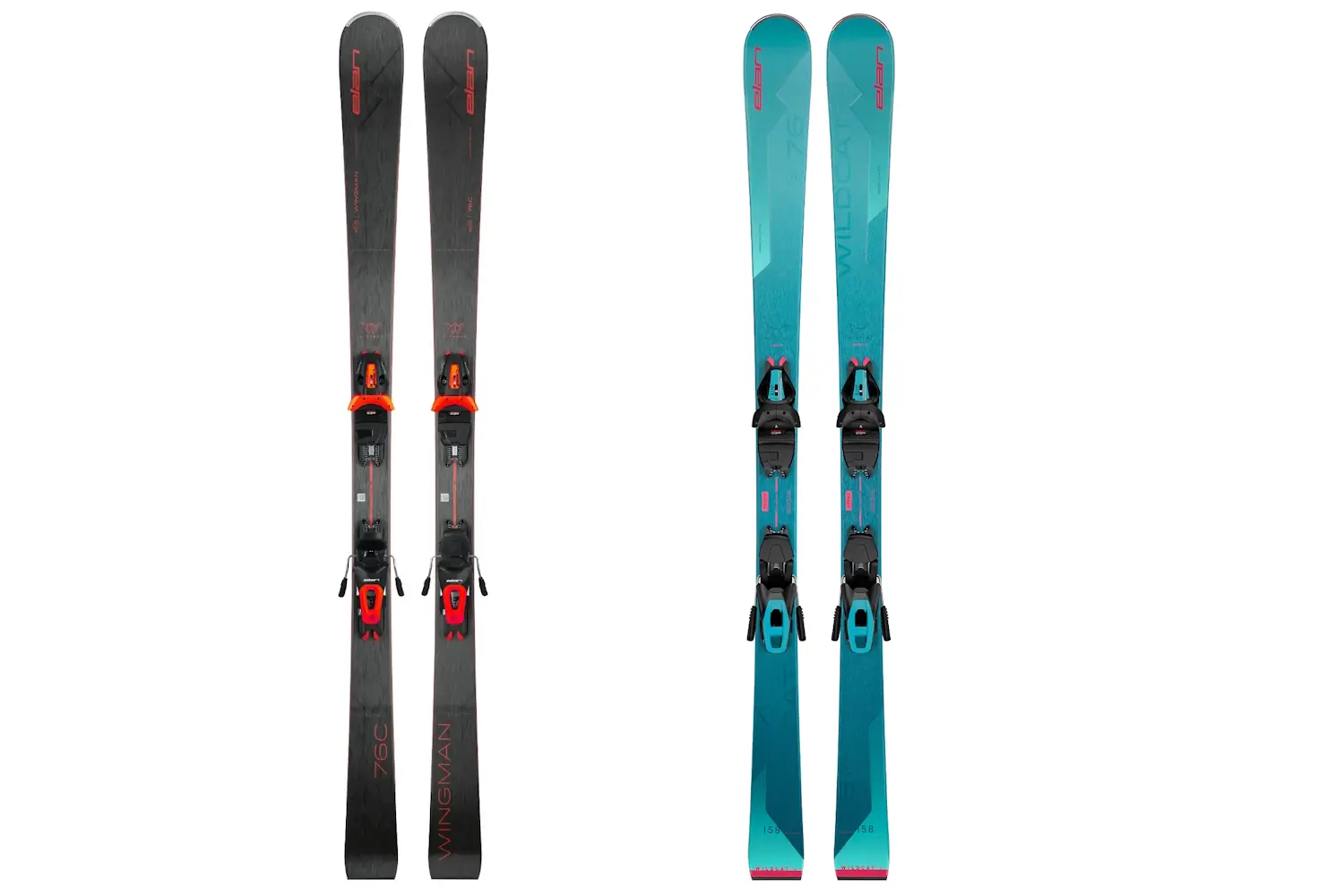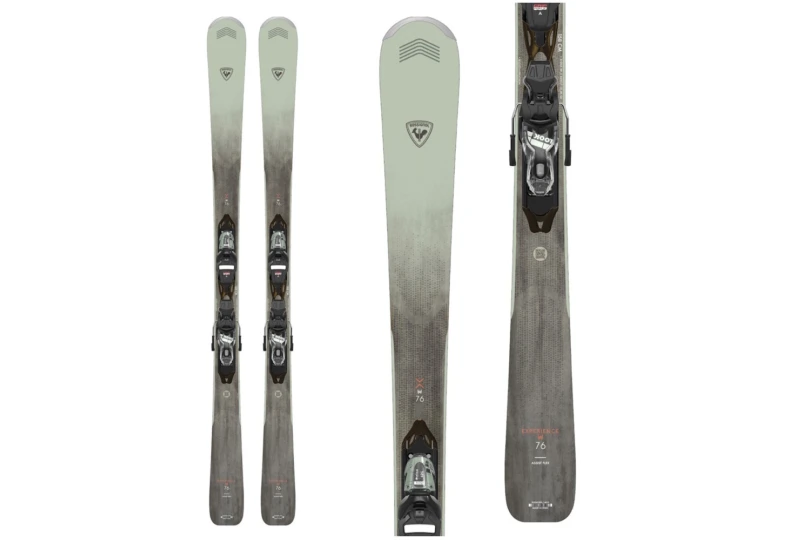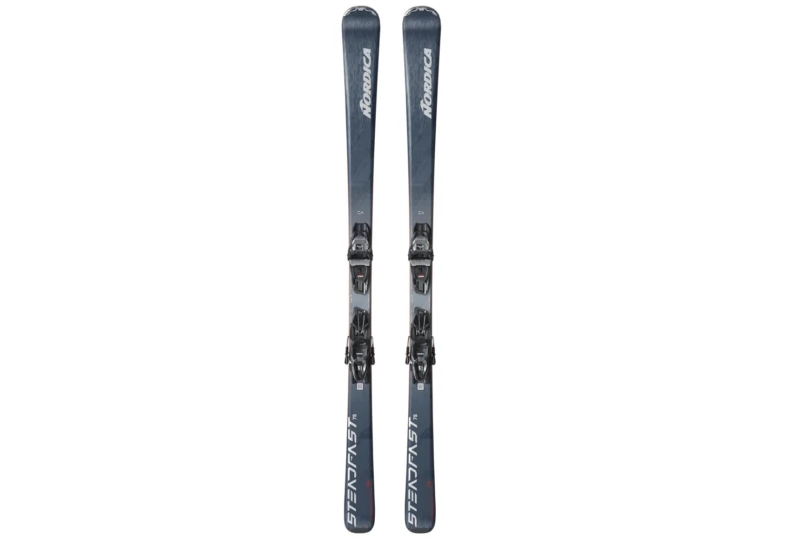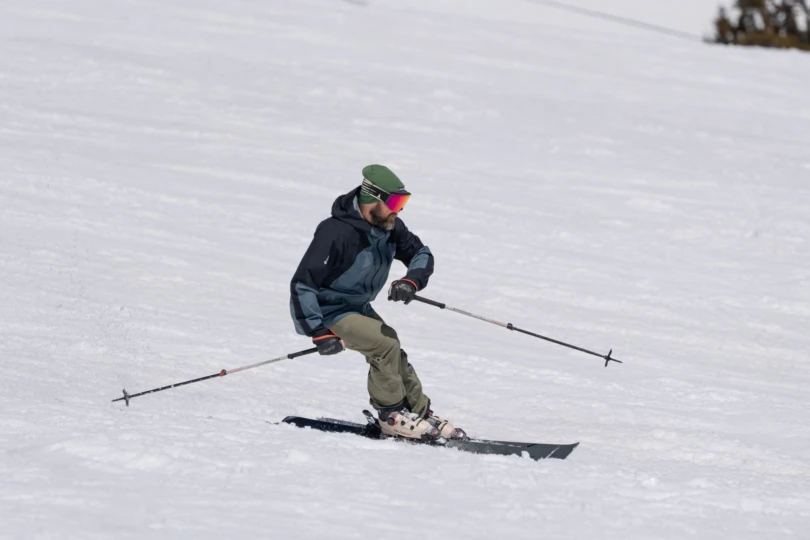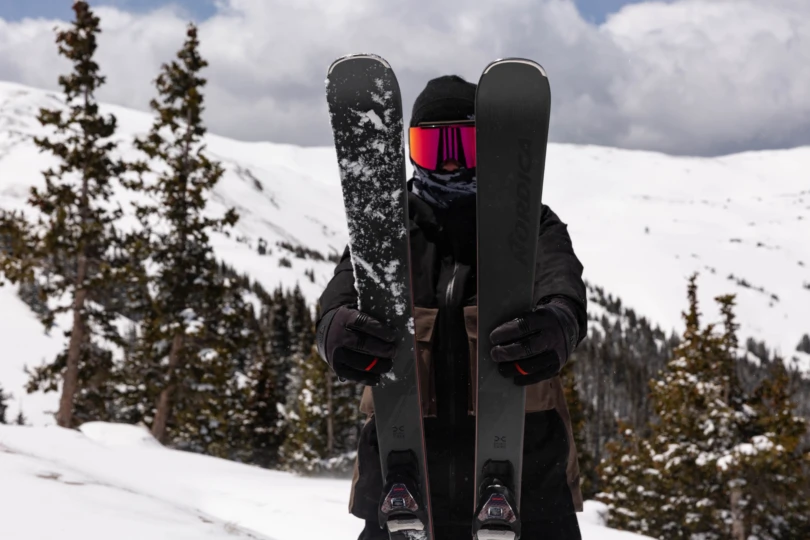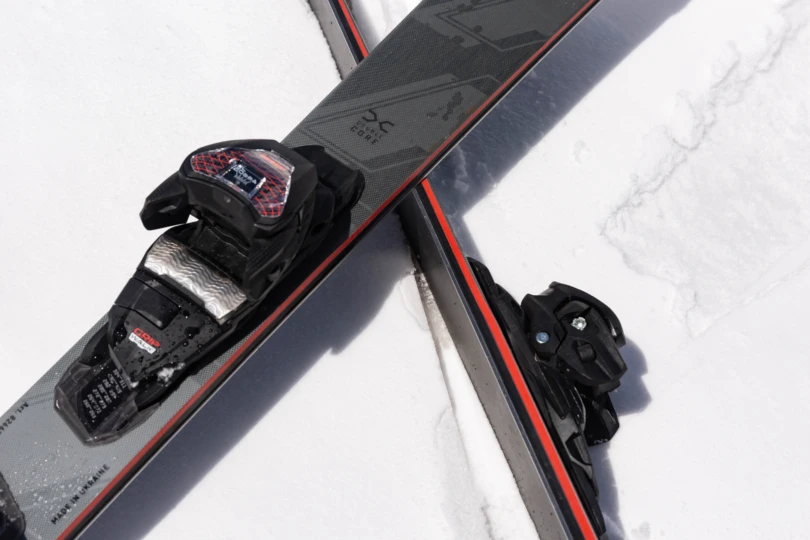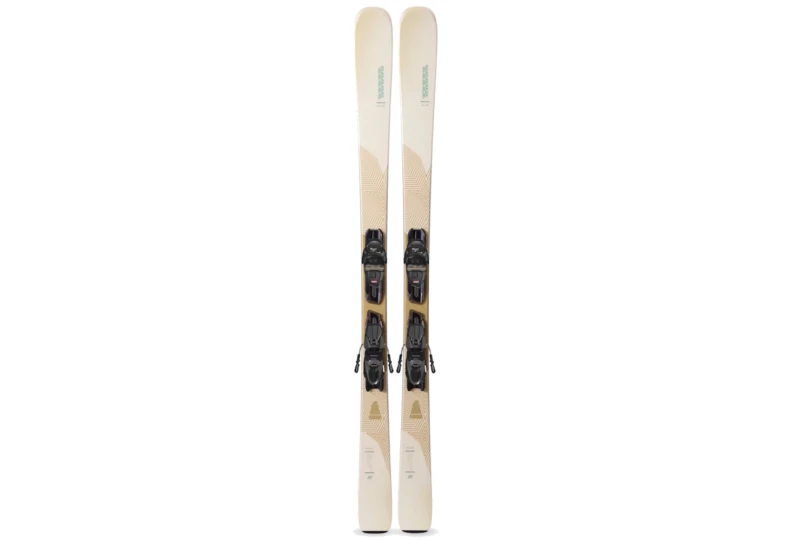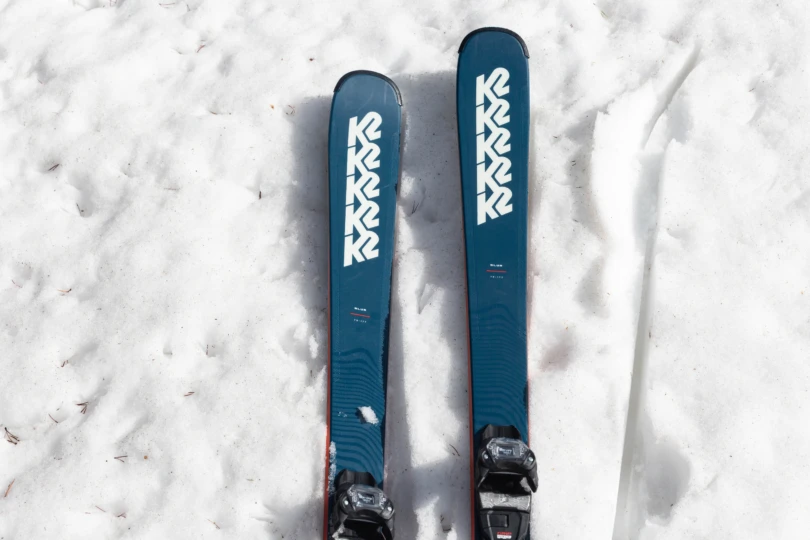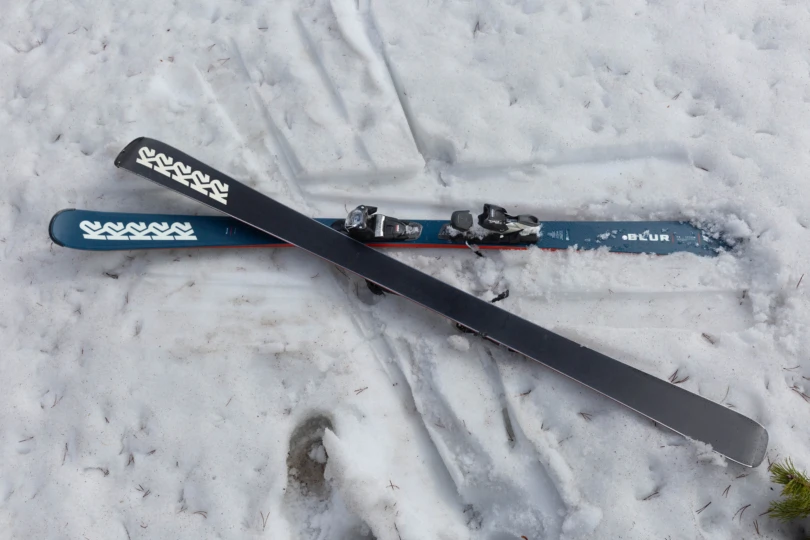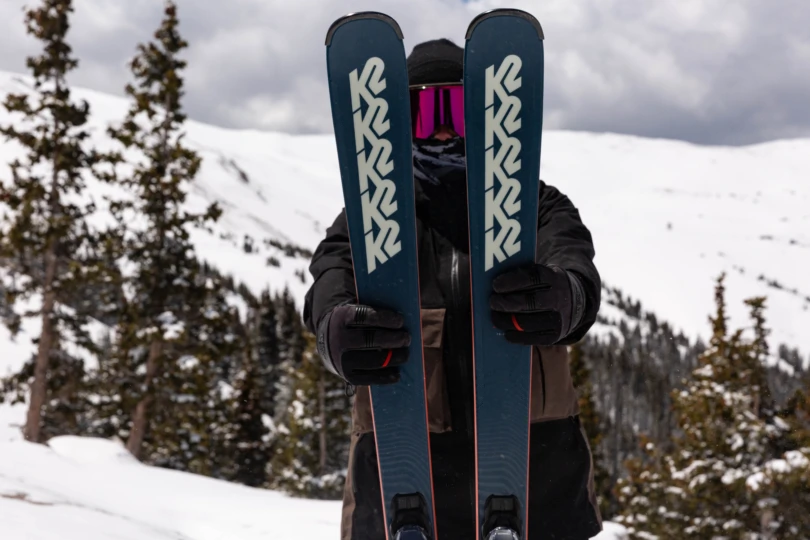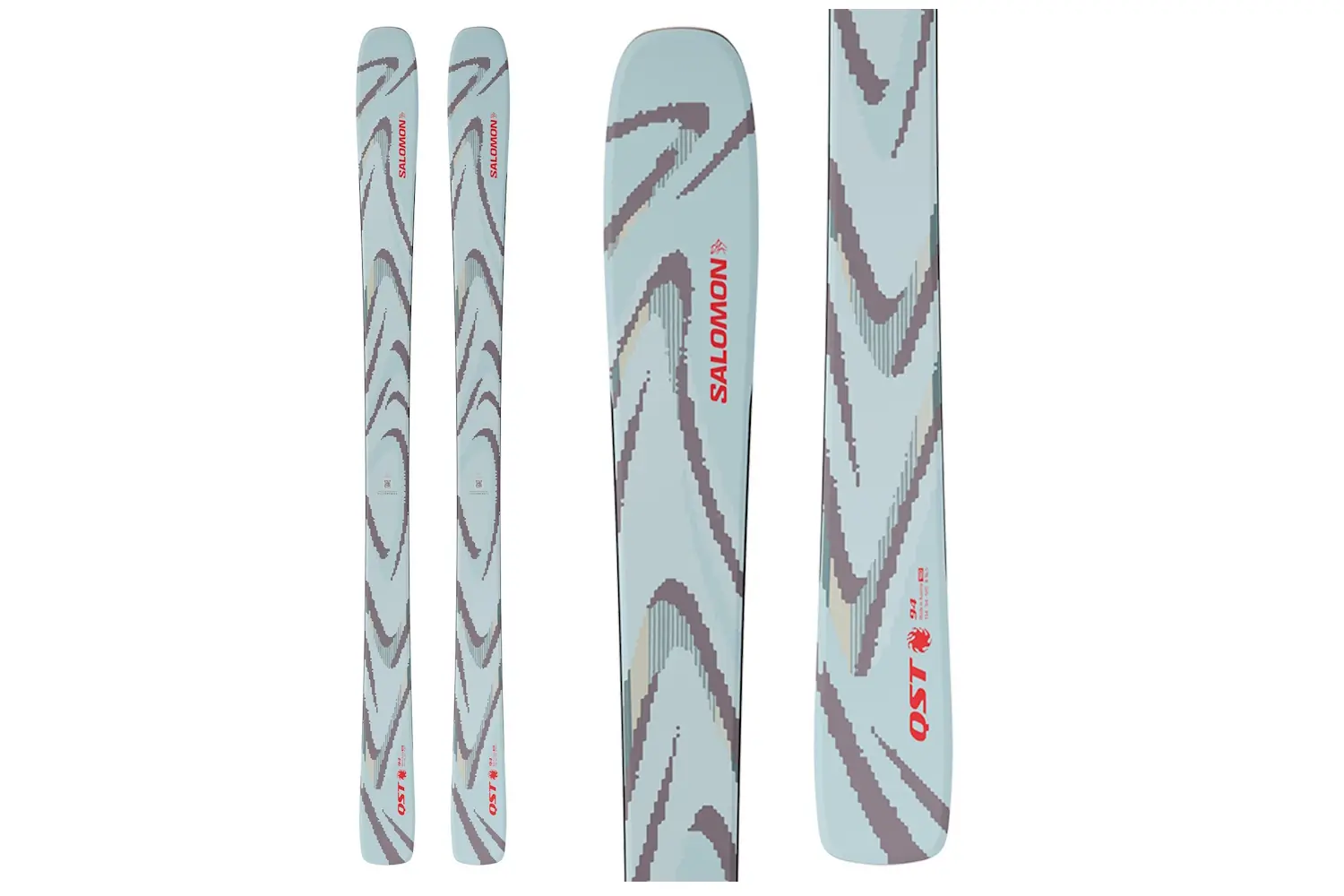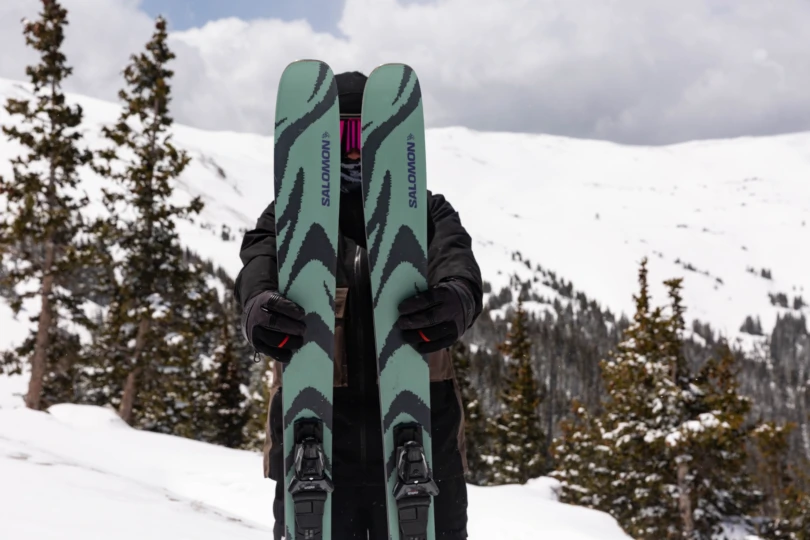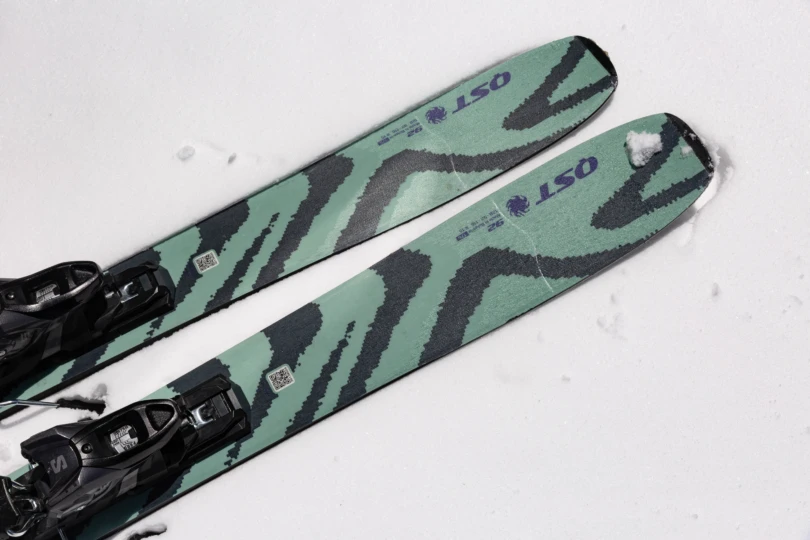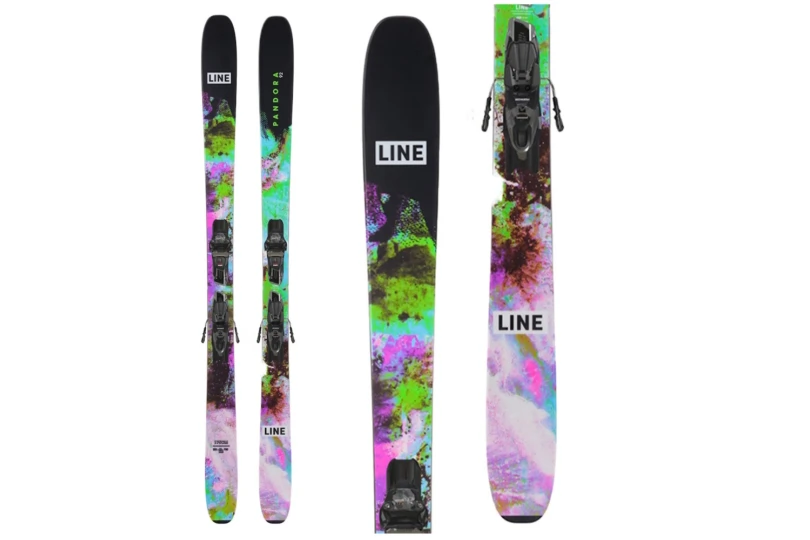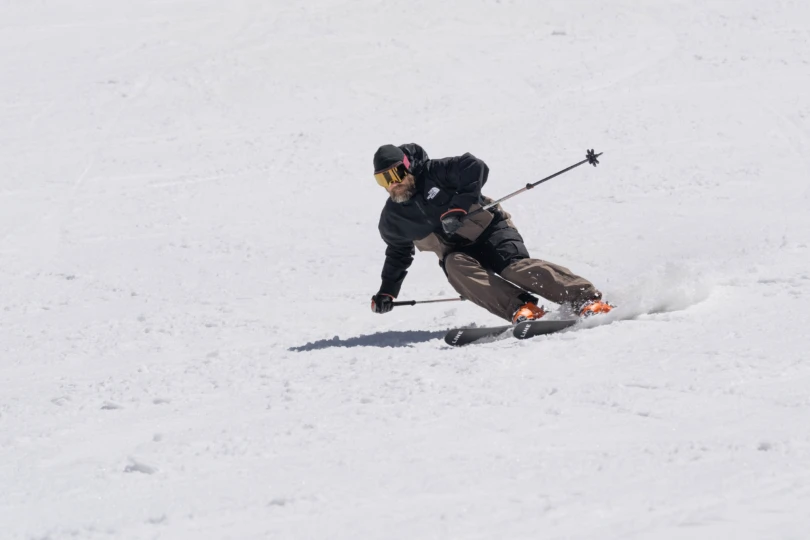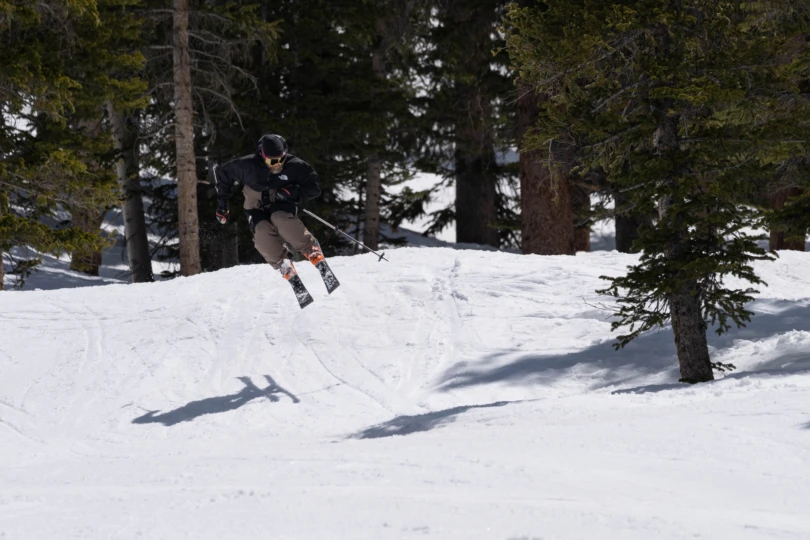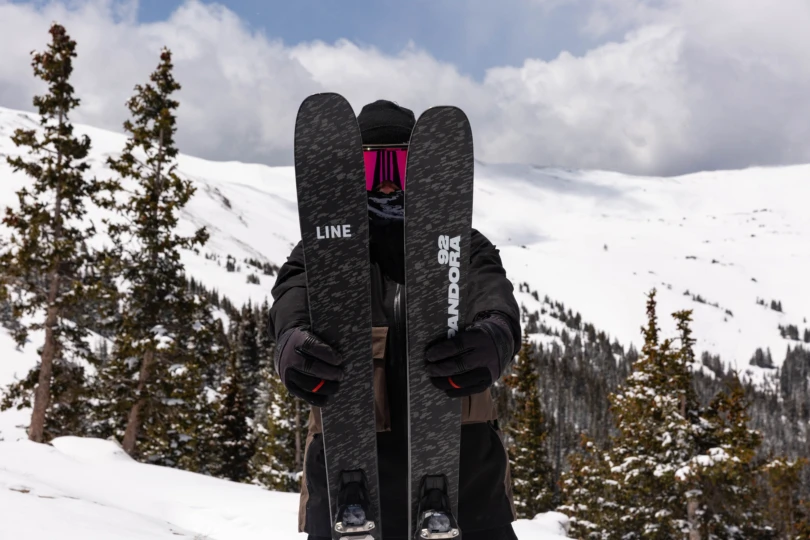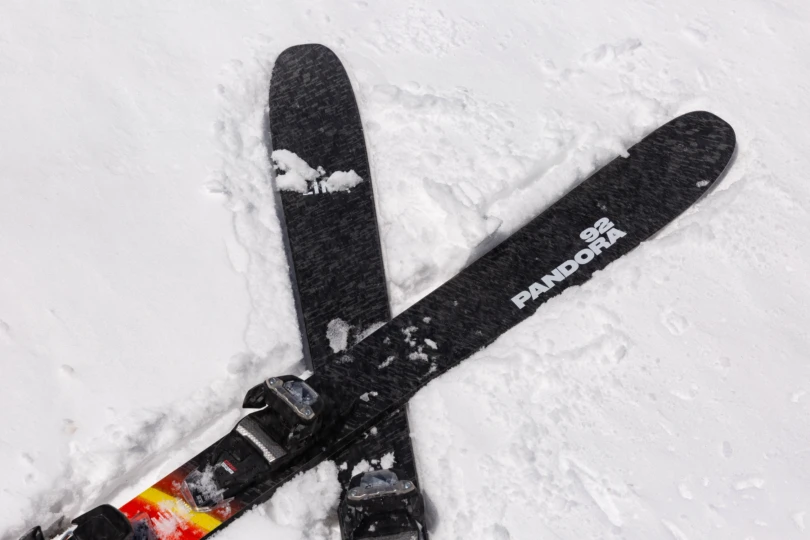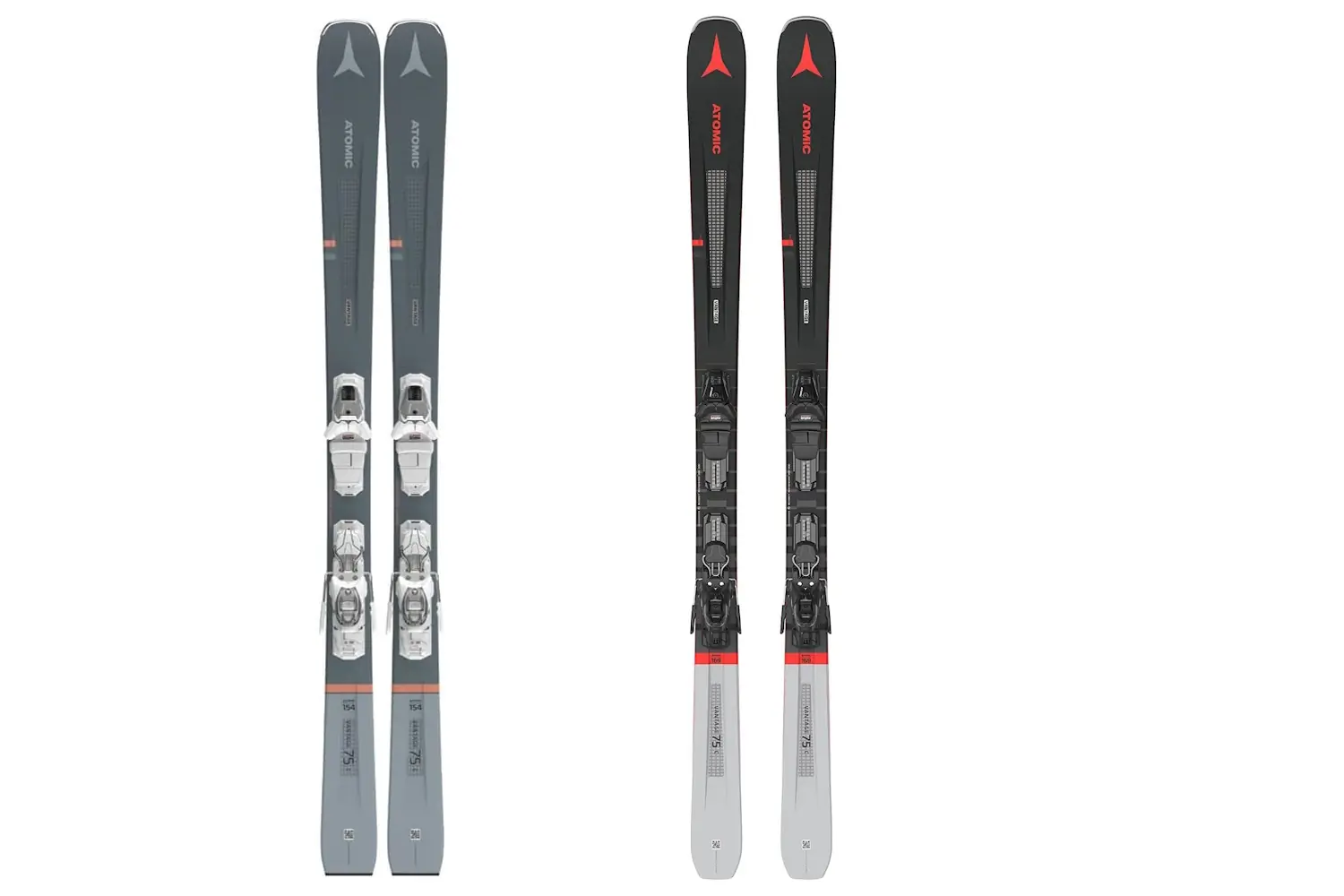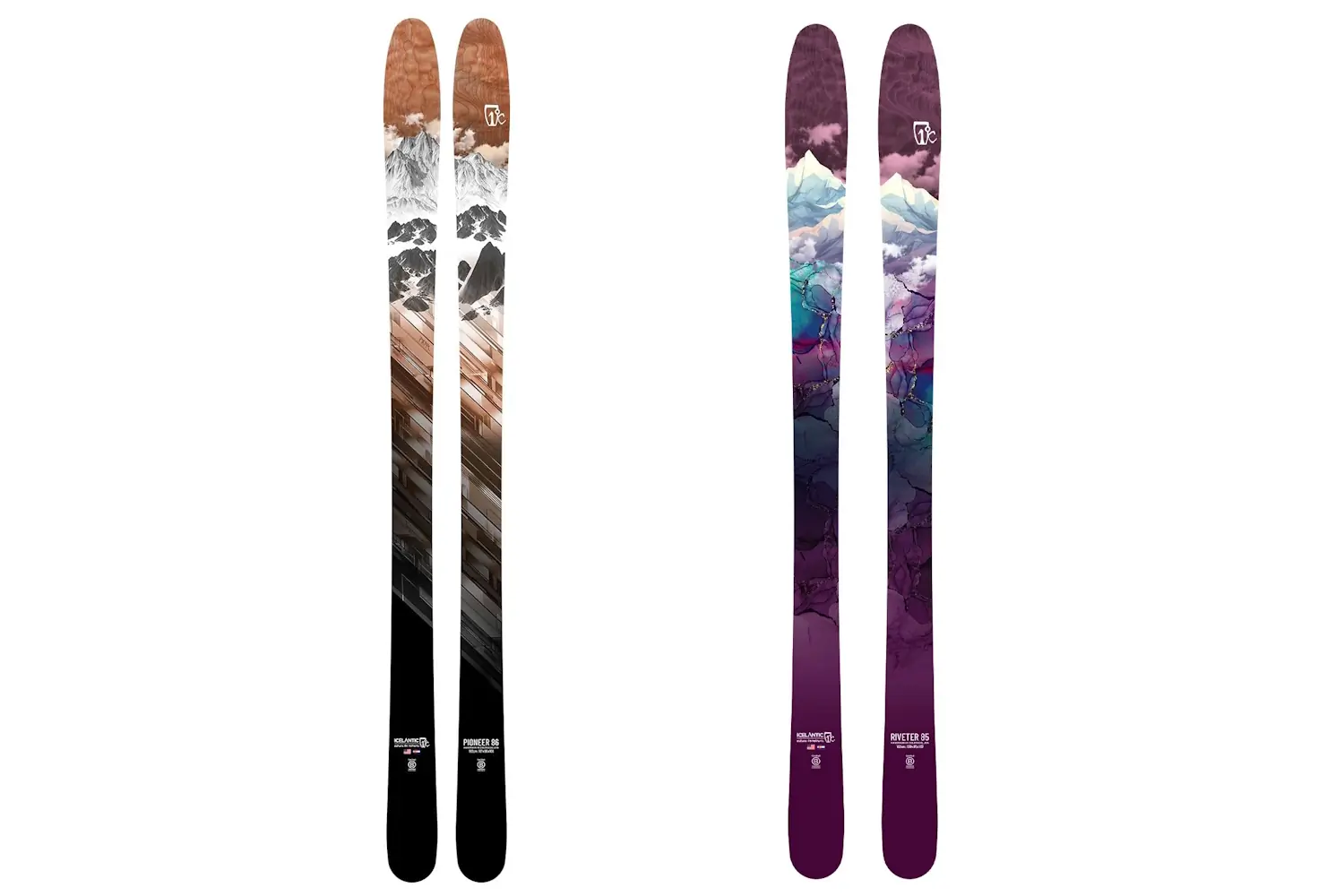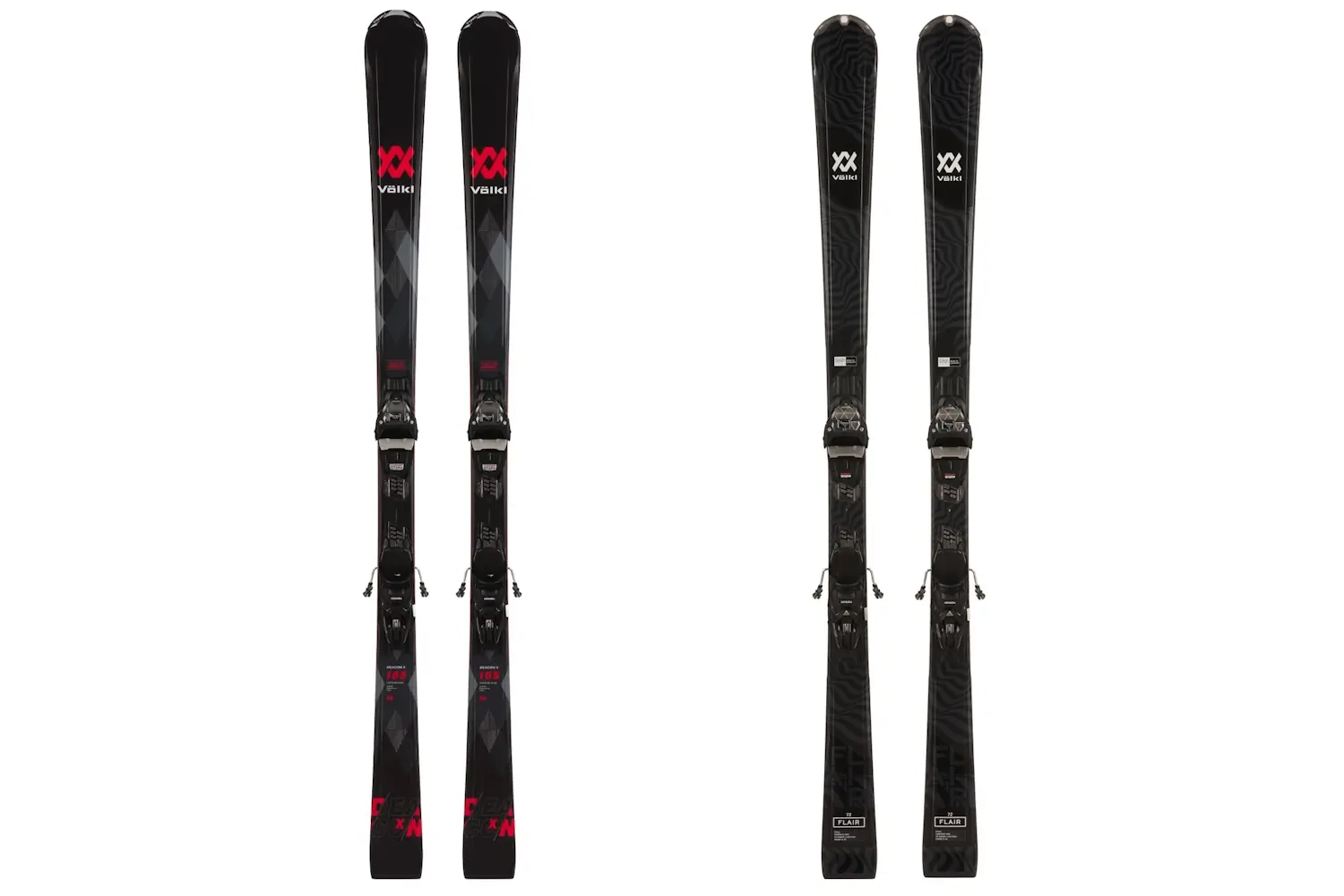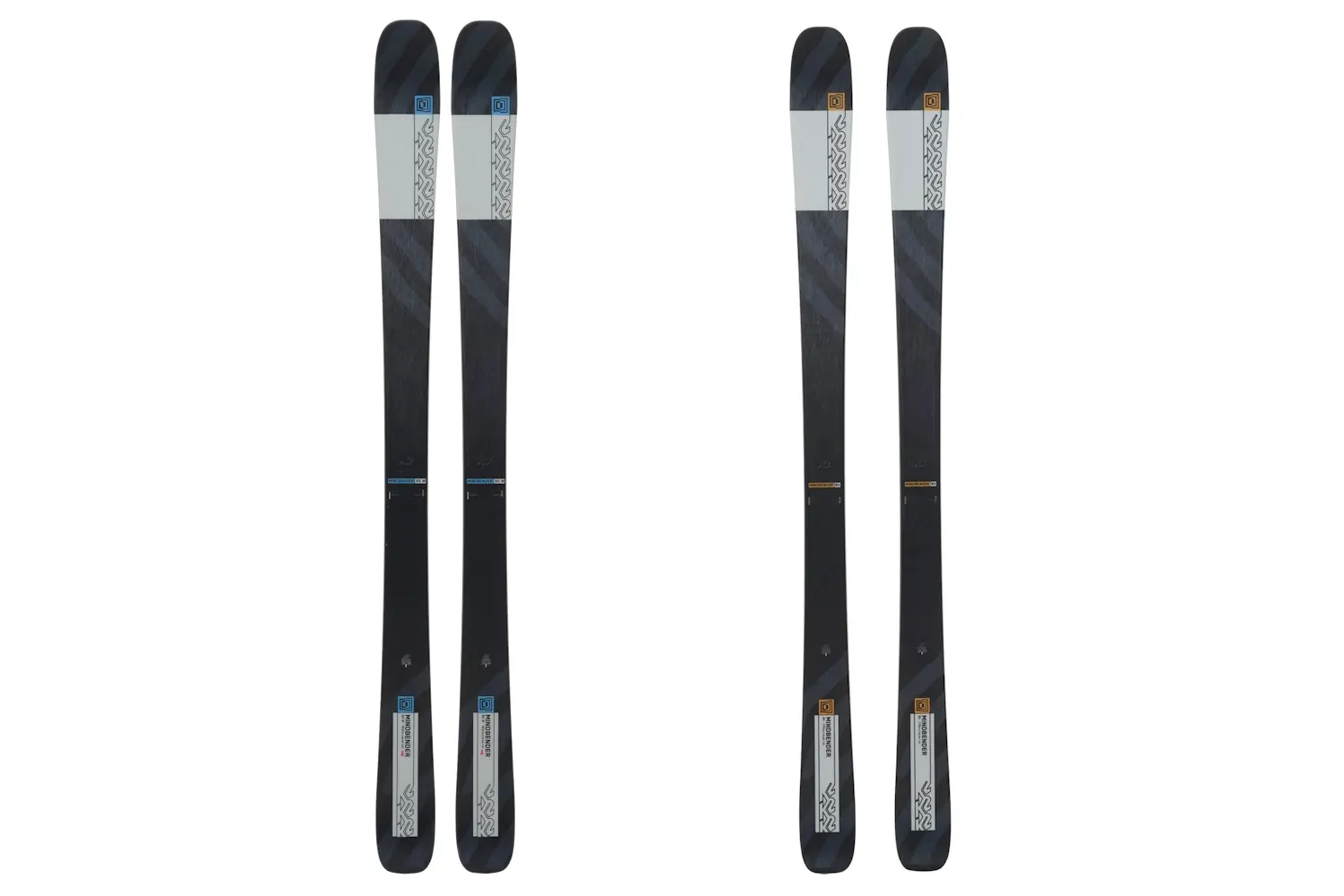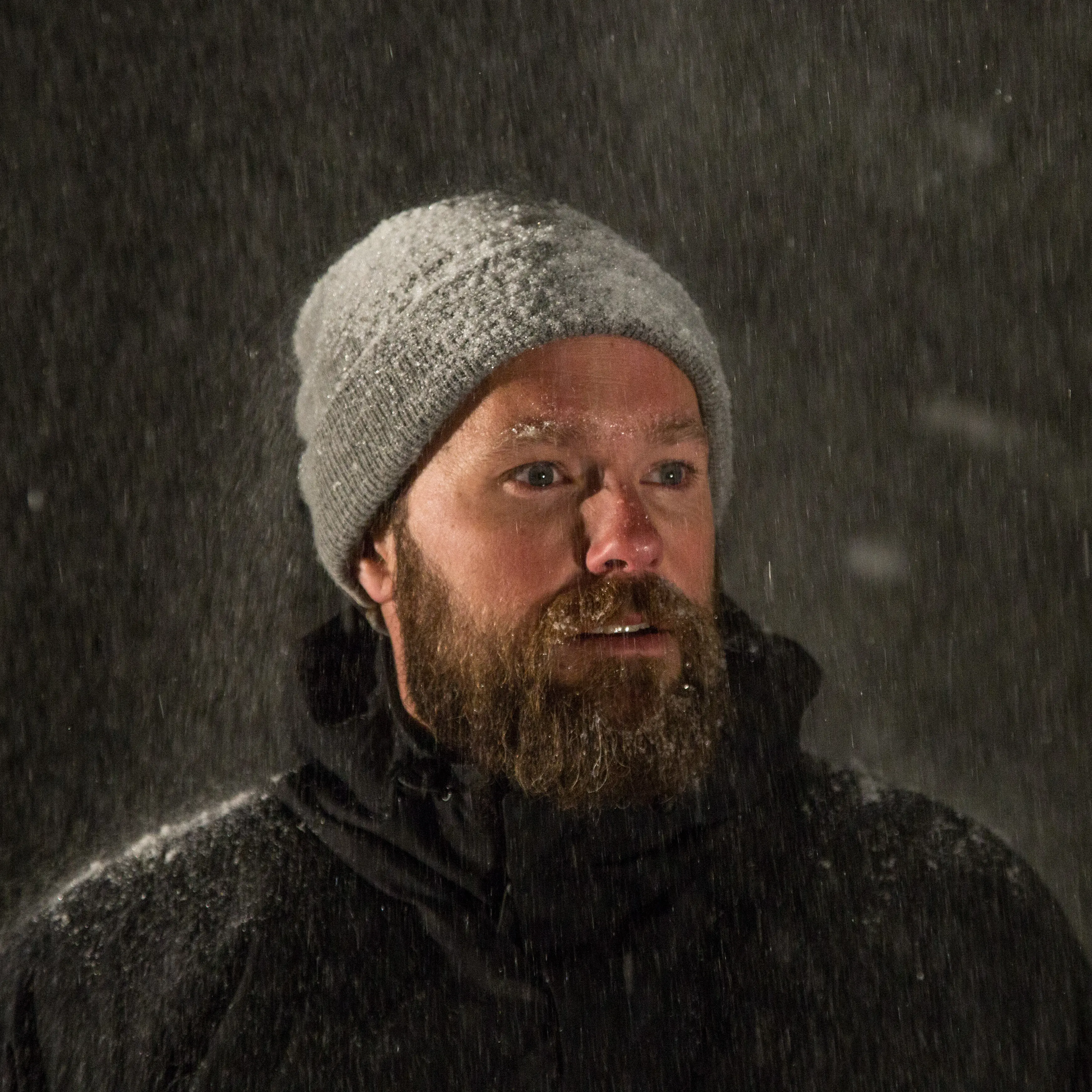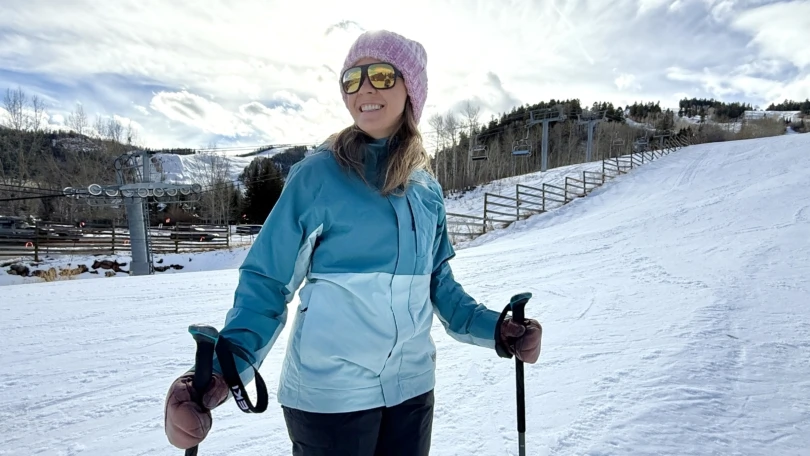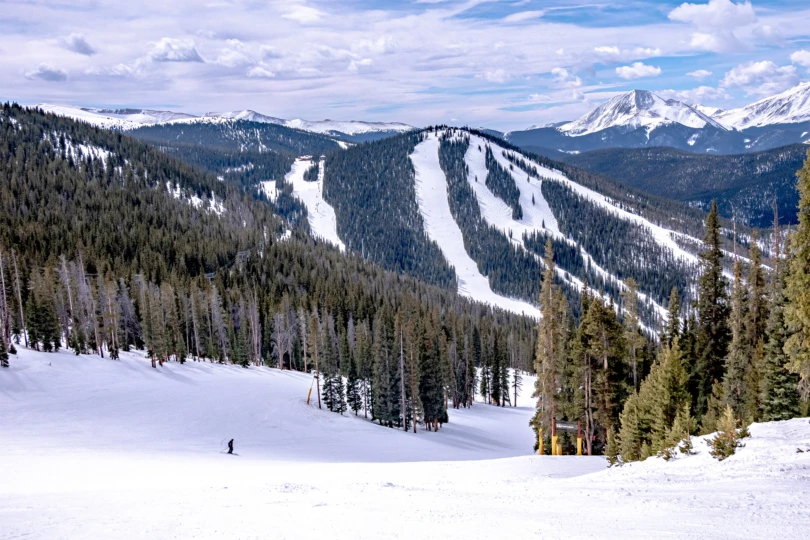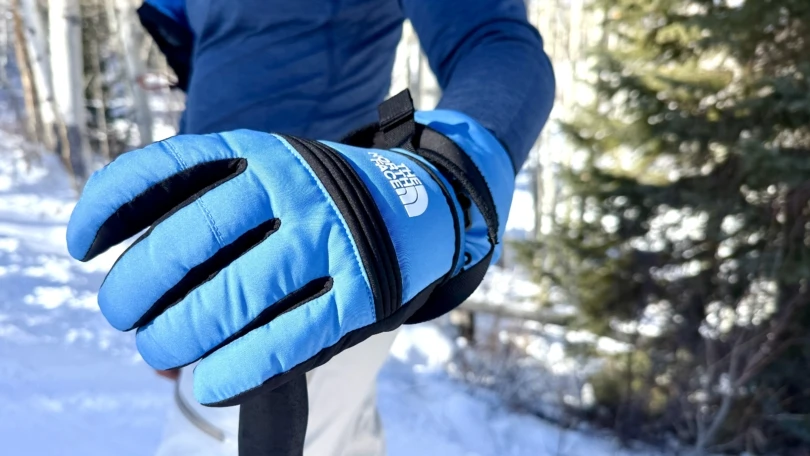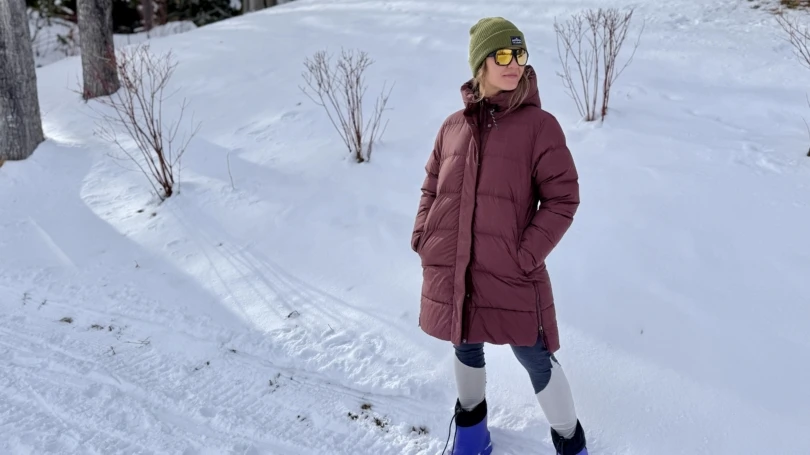Learning to downhill ski? All-mountain skis are like your trusty wingman, built to take you anywhere on the mountain.
“All-mountain” is a broad category nearly every ski brand has in the lineup. The skis share one core trait: they’re built to carve groomers on the resort’s frontside. But they’re not one-trick ponies. They can also handle a layer of fresh snow, which changes up the feel of the slope, and many hold their own in powder, bumps, or tree runs.
Designs like the Elan Men’s Wingman 78 C are cambered, with a bit of tip and tail rise for a grounded, but less edgy feel. Other budget designs are less finessed, but include bindings such as the Rossignol Men’s Experience 76. Beginner all-mountain skis generally carry entry-level price tags and are easier to control on the slopes, which helps new skiers hone their skills and technique.
Here, we’ve selected the best all-mountain skis for first-timers and new students looking to exit the rental pool, as well as skis for goal-oriented newbies eager to advance to more vigorous lines around the mountain.
Editor’s Note: We updated our Skis for Beginners guide on September 23, 2025, with the field-tested Salomon QST 94, Line Pandora 92, K2 Blur 79, and Nordica Steadfast 75.
The Best Skis for Beginners of 2025-2026
Elan Men’s Wingman 78 C & Women’s Wildcat 76
- Profile: Camber underfoot, rocker in the tip and tail
- Sidecut radius: Short
- Width (mm): 127 tip, 76 waist, 104 tail (women’s Wildcat); 125 tip, 78 waist, 104 tail (men’s Wingman)
- Bindings included: ELK 9.0 GW (women’s), PS ELX 10.0 GW (men’s)
- Lengths/sizes (cm): 144, 150, 158, 166 (women’s Wildcat) & 160, 168, 176 (men’s Wingman)
Pros
- Forgiving for students while they establish skills
- Great on-piste ski
Cons
- Not a premier choice for powder days
- Narrower width can be a drawback for heavier or more experienced skiers
Rossignol Men’s Experience 76 & Women’s Experience 76
- Profile: 70% camber plus a mellow rocker in the ski tips and flat tails
- Sidecut radius: Short
- Women’s Experience 76 Width (mm): 123 tip, 76 waist, 109 tail (women’s Experience); 123 tip, 76 waist, 109 tail (men’s Experience)
- Bindings included: Xpress 10 GW
- Lengths/sizes (cm): 136, 144, 152, 160 (women’s) & 152, 160, 168, 176 (men’s)
Pros
- 100% recycled steel
- Base is made with 30% recycled materials
- PEFC (Programme for the Endorsement of Forest Certification) certified poplar wood
Cons
- Not first choice for day one on the slopes
Nordica Steadfast 75 CA FDT
- Profile: On-piste rocker
- Sidecut radius: 15.4 m (size 174)
- Width (mm): 75, 80
- Bindings included: pre-mounted with TP2 Compact 10 FDT bindings, offering a DIN range of 3–10 ML
- Lengths/sizes (cm): 150, 156, 162, 170, 177
Pros
- More approachable than most Nordica skis
- Very affordable with integrated bindings
Cons
- Boring topsheet graphics
K2 Blur 79 with QuikClik Bindings
- Profile: All-terrain rocker
- Sidecut radius: 16.3 m (size 177)
- Widths (mm): 74, 76, 79
- Bindings included: M3 11 TCx light Quikclik
- Lengths/sizes (cm): 156, 163, 170, 177
Pros
- Shape and construction encourage good technique
- Affordable setup with integrated bindings
- Lightweight for quicker turns and less fatigue
Cons
- Limited performance off-trail
Salomon QST 94 Ski
- Profile: Rocker/camber/rocker
- Sidecut radius: 16.5 m (size 180)
- Width (mm): 94, 100, 106
- Bindings included::
- Lengths/sizes (cm): 156, 164, 172, 180, 188
Pros
- Capable carver away from ice
- Outperforms its width in soft snow
- Energetic flex
Cons
- Stiff for beginning skiers
- Narrow for deep snow
Line Pandora 92 plus Squire 10 Bindings
- Profile: All-terrain rocker
- Sidecut radius: 17 m (size 182)
- Waist (mm): 85, 92, 99, 106
- Bindings included: Squire 10
- Lengths/sizes (cm): 147, 154, 161, 168, 175, 182
Pros
- Lightweight construction
- Rounded tips and tails accommodate variety of ski styles
Cons
- Less stable and precise on hard snow
Our Other Favorite Skis for Beginners
- Profile: Cambered ski with rockered tips and flat tails
- Sidecut radius: Short
- Width (mm): 112-115 tip, 75 waist, 97-100 tail (women’s Vantage 75); 113-118 tip, 75 waist, 98-103 tail (men’s Vantage 75 C)
- Bindings included: M 10 GW
- Lengths/sizes (cm): 140, 147, 154, 161 (women’s Vantage 75) & 147, 154, 161, 169, 177 (men’s Vantage 75 C)
Pros
- Confidence-building ski
- Effortless to control
Cons
- Topsheet delaminates faster than higher-end skis
- Doesn’t handle high speeds well
- Not a great choice for aggressive, big carves
- Profile: Rocker in the tips and tails and camber underfoot
- Sidecut radius: Short
- Width (mm): 120 tip, 85 waist, 107 tail (women’s Riveter); 121 tip, 86 waist, 108 tail (men’s Pioneer)
- Bindings included: No
- Lengths/sizes (cm): 150, 155, 162, 169 (women’s) & 166, 174, 182 (men’s)
Pros
- Fairly soft flex
- Directional design
Cons
- Not ideal for completely green skiers
- Bindings not included
- Profile: Classic camber profile with an early-rise rocker in the tip and flat tail
- Sidecut radius: Short
- Width (mm): 123 tip, 72 waist, 104 tail (women’s Flair); 123 tip, 72 waist, 104 tail (men’s Deacon)
- Bindings included: vMotion 10 GW
- Lengths/sizes (cm): 137, 144, 151, 158, 165 (women’s) & 151, 158, 165, 172 (men’s)
Pros
- Great agility for activating and following through short turns
- Excels on groomers and handles a variety of snow conditions fairly well
Cons
- Not the strongest design for long, accelerating arched turns
- Profile: Gradual rise in the tip, short rise in the tail, and camber underfoot
- Sidecut radius: Short
- Width (mm): 130 tip, 85 waist, 113 tail (women’s Alliance); 130 tip, 85 waist, 113 tail (men’s Mindbender)
- Bindings included: No
- Lengths/sizes (cm): 149, 156, 163, 170 (women’s) & 156, 163, 170, 177 (men’s)
Pros
- Well-built for cruisers on good snow
- A good choice for beginner or intermediate skiers
- Handles groomers as well as a bit of powder, moguls, and tree runs
Cons
- Bindings not included
- With the width and build, the edge-to-edge is a tad slower
- A tad soft for true hardpack
All-Mountain Skis for Beginners Comparison Chart
Scroll right to view all of the columns: Price, Profile, Sidecut radius, Width (mm), Bindings included, Lengths/Sizes (cm).
| Skis | Price | Profile | Sidecut radius | Width (mm) | Bindings included | Lengths/sizes (cm) |
|---|---|---|---|---|---|---|
| Elan Men’s Wingman 78 C & Women’s Wildcat 76 | $600 | Camber underfoot, rocker in the tip and tail | Short | 127 tip, 76 waist, 104 tail (women’s Wildcat); 125 tip, 78 waist, 104 tail (men’s Wingman) | ELW 9.0 GW (women’s), PS ELW 10.0 GW (men’s) | 144, 150, 158, 166 (women’s Wildcat) & 160, 168, 176 (men’s Wingman) |
| Atomic Men’s Vantage 75 C & Women’s Vantage 75 | $480-600 | Cambered ski with rockered tips and flat tails | Short | 112-115 tip, 75 waist, 97-100 tail (women’s Vantage 75); 113-118 tip, 75 waist, 98-103 tail (men’s Vantage 75 C) | M 10 GW | 140, 147, 154, 161 (women’s Vantage 75) & 147, 154, 161, 169, 177 (men’s Vantage 75 C) |
| Icelantic Men’s Pioneer 86 & Women’s Riveter 85 | $729 | Rocker in the tips and tails and camber underfoot | Short | 120 tip, 85 waist, 107 tail (women’s Riveter); 121 tip, 86 waist, 108 tail (men’s Pioneer) | No | 150, 155, 162, 169 (women’s) & 166, 174, 182 (men’s) |
| Rossignol Men’s Experience 76 & Women’s Experience 76 | $450-480 | 70% camber plus a mellow rocker in the ski tips and flat tails | Short | 123 tip, 76 waist, 109 tail (women’s Experience); 123 tip, 76 waist, 109 tail (men’s Experience) | Xpress 10 GW | 136, 144, 152, 160 (women’s) & 152, 160, 168, 176 (men’s) |
| Nordica Steadfast 75 CA FDT | $530 | On-piste rocker | 15.4 m (size 174) | 75, 80 | pre-mounted with TP2 Compact 10 FDT bindings, offering a DIN range of 3–10 ML | 150, 156, 162, 170, 177 |
| K2 Blur 79 with QuikClik Bindings | $750 | All-terrain rocker | 16.3 m (size 177) | 74, 76, 79 | M3 11 TCx light Quikclik | 156, 163, 170, 177 |
| Salomon QST 94 Ski | $700 | Rocker/camber/rocker | 16.5 m (size 180) | 94, 100, 106 | No | 156, 164, 172, 180, 188 |
| Line Pandora 92 plus Squire 10 Bindings | $750 | All-terrain rocker | 17 m (size 182) | 85, 92, 99, 106 | Squire 10 | 147, 154, 161, 168, 175, 182 |
| Völkl Men’s Deacon X & Women’s Flair 72 | $500 | Classic camber profile with an early-rise rocker in the tip and flat tail | Short | 123 tip, 72 waist, 104 tail (women’s Flair); 123 tip, 72 waist, 104 tail (men’s Deacon) | vMotion 10 GW | 137, 144, 151, 158, 165 (women’s) & 151, 158, 165, 172 (men’s) |
| K2 Men’s Mindbender 85 & Women’s Mindbender 85 Alliance | $450 | Gradual rise in the tip, short rise in the tail, and camber underfoot | Short | 130 tip, 85 waist, 113 tail (women’s Alliance); 130 tip, 85 waist, 113 tail (men’s Mindbender) | No | 149, 156, 163, 170 (women’s) & 156, 163, 170, 177 (men’s) |

How We Tested All-Mountain Skis for Beginners
Whether we’re sitting with our friends on the chairlift or writing a guide, at GearJunkie, our goal is to provide the most accurate, up-to-date, and highest quality advice possible. We want you to find the best ski for your needs and where you most enjoy turns.
Our Expert Testers
Based in Colorado, contributor Justin Park skis more than 100 days each season, split evenly between backcountry and resort days. From sub-zero January pow days to slushy June touring missions, he puts dozens of jackets, skis, boots, and pants through their paces at high elevations.
Another leader of these test laps is GearJunkie Editorial Director Sean McCoy, in addition to other all-mountain skiers who contributed feedback for this guide. For context, he’s an aggressive skier with 40 years of experience. McCoy is 5’8″ and 155 pounds. He started skiing at 4 years old, slogging across snow-covered golf courses with his parents on ancient wooden cross-country skis. That was in the 1970s. He now tends to favor wider skis in his home mountains in Colorado.
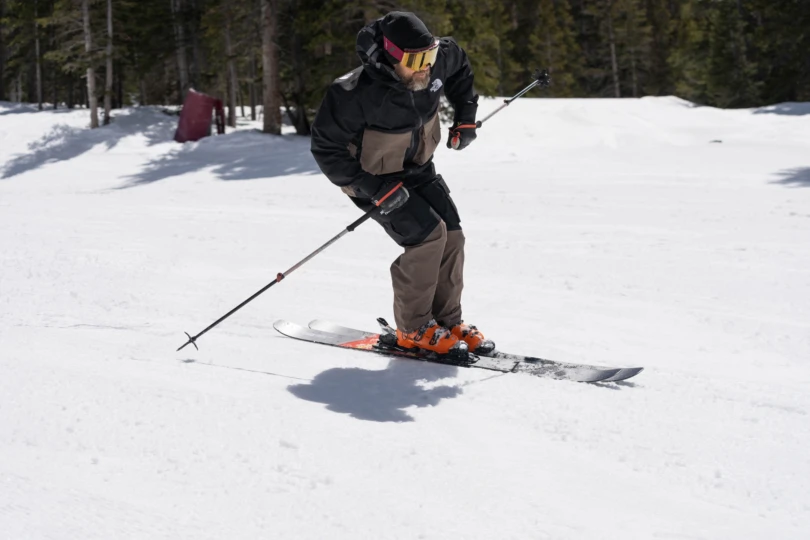
Our Testing Grounds
Season and season, our editors and freelance testers put ski models through the grind on our home turf, through various industry on-snow events, demoing the newest and next year’s models, with a concentration in the West.
We occasionally meet for a week-long ski test, including two former events at Crested Butte Mountain Resort as a crew. Those hours stack up, in addition to decades of experience we’ve each built clicked into ski bindings.
Our Testing Process
While testing all-mountain skis, we assess a range of factors including each design’s stiffness, maneuverability, and playfulness as well as the ski’s energy, damping, chatter, weight, shape, edge hold, and turn initiation. The base and edge tune also influence how a ski performs. We considered what type of skier and conditions are the best fit for each ski.
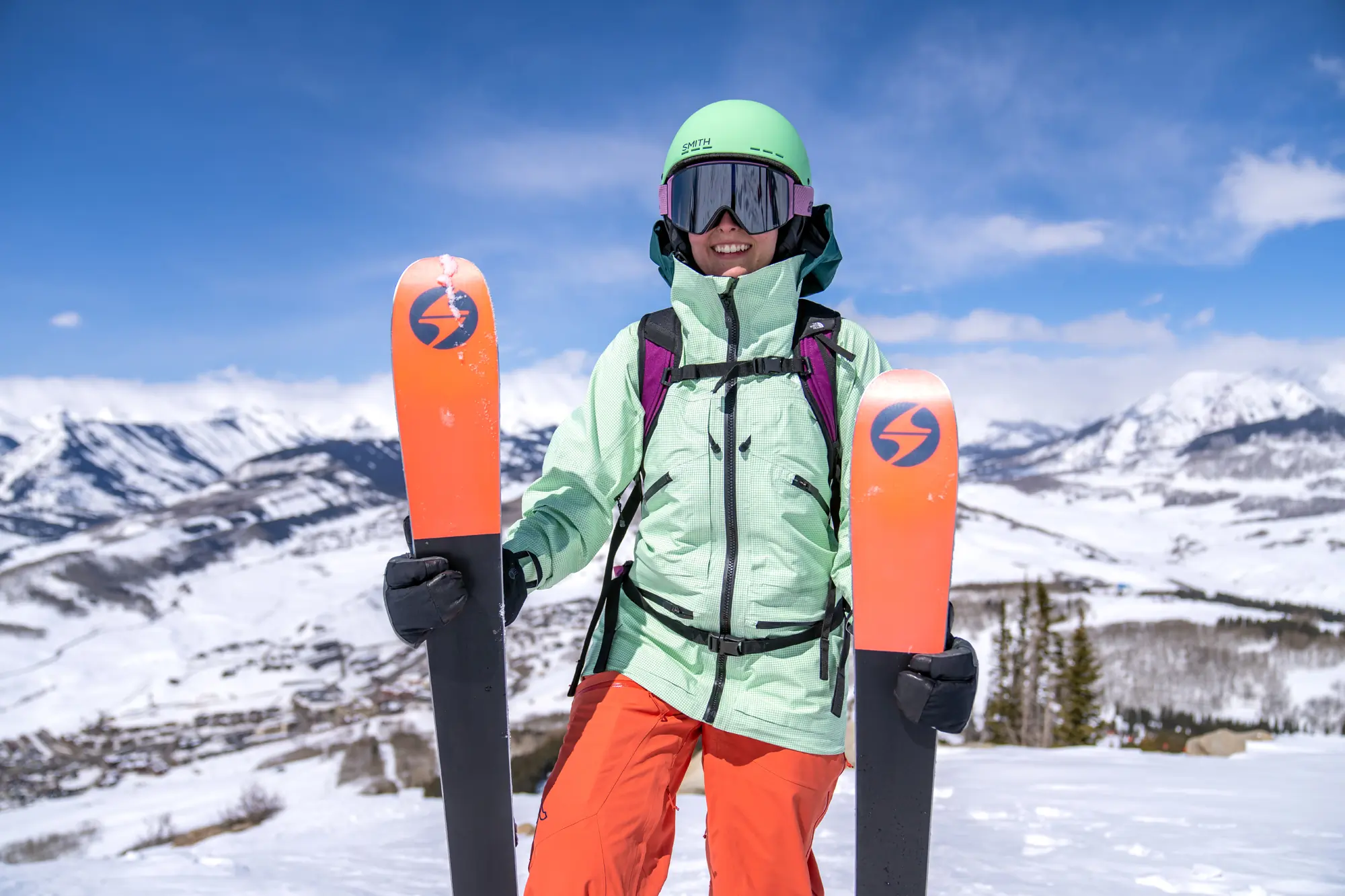



In this case, we are looking for a ski that is friendly to initiate turns, forgiving on an edge (not grabby), not too stiff, and not too expensive, either. It’s also nice to have bindings included in the package for beginners.
In addition to our team’s field experience, we consider the most popular, innovative, award-winning, and bestselling skis on the market as well as a broad range of price points and a variety of features and applications.
Finally, we meet with brands throughout the year to learn about their top products. We carefully research these skis before selecting only the most promising for real-world testing.
The result of these hundreds of hours of work is the buyer’s guide you see before you. And we will update this guide multiple times each year to keep it timely and relevant to help you pick the best beginner all-mountain skis for your needs.


Buyer’s Guide: How to Choose Beginner All-Mountain Skis
As you excitedly choose your first pair of downhill skis, you’ll need to consider the best type of ski for you and a few qualities that differentiate each ski model.
Generally, skis are categorized as all-mountain, all-mountain wide, powder, and backcountry. For this guide, we focus on all-mountain skis, which we’ve found the most suitable for skiers just getting started.
All-Mountain Skis
All-mountain is a broad category that includes quality, nuanced builds manufactured by nearly every brand in the ski industry. Each ski model feels unique but also has common traits.
Namely, all-mountain skis handle hardpack groomed runs on the frontside of the ski resort. They can also manage some fresh snowfall, which softens the slope and leads to snowpack variability.
That said, some all-mountain skis carve packed runs better than they navigate soft, fluffy, or deep snow or cut through variability like choppy conditions or ice. Some all-mountain skis perform better than others in powder, on moguls, or whipping through the trees.
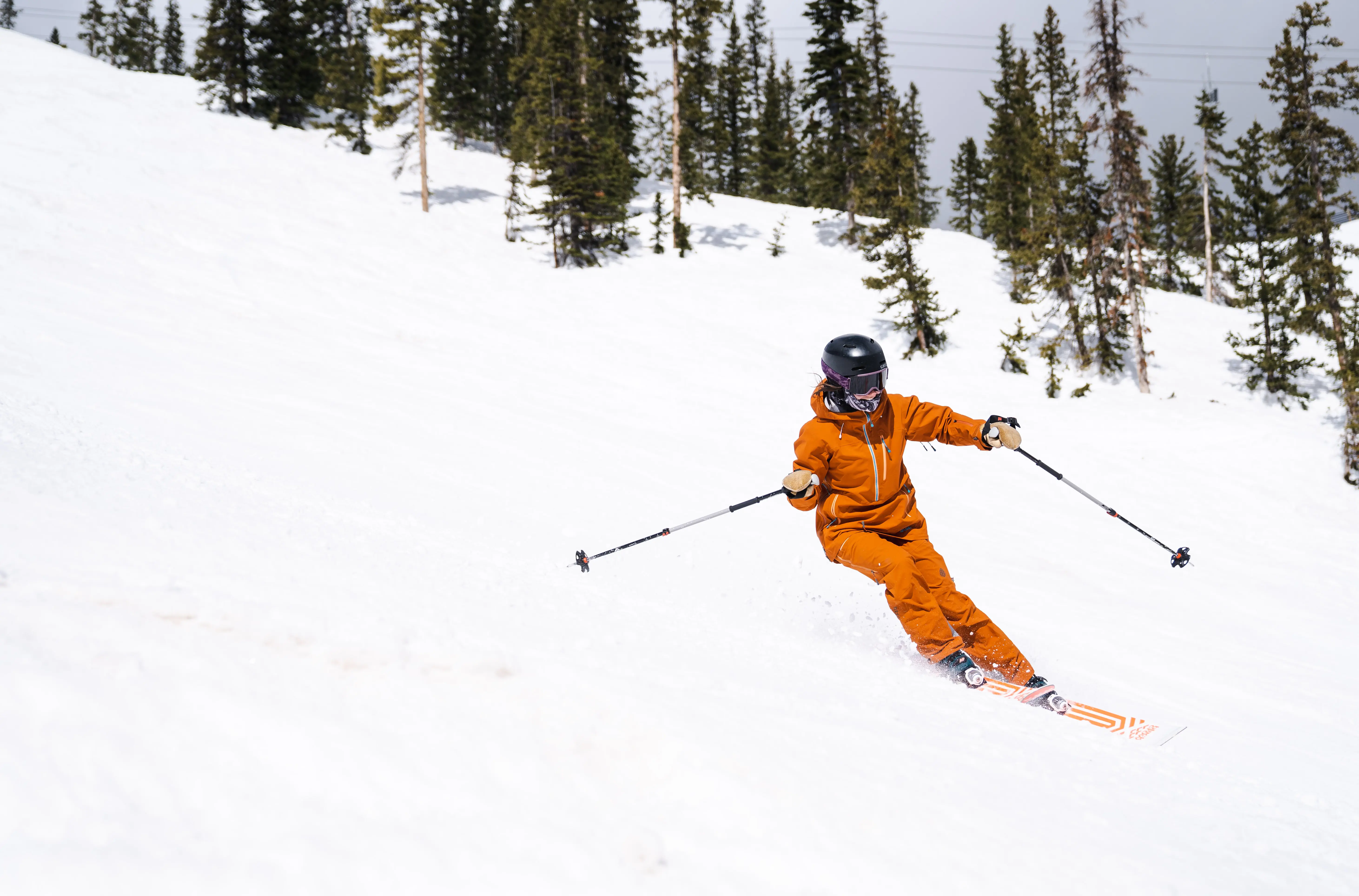



Beginner All-Mountain Skis
Beginner all-mountain skis usually cost less and feature integrated bindings. The economic price reflects a construction that is typically softer. These skis are more flexible on the snow, turning feels easier, and the ride is less aggressive. Beginner-friendly designs are also usually narrower.
All of these characteristics complement skiing on groomed runs, which is usually where beginners spend the majority of their shred day. The best skis for beginners range from true first-timer skis to skis that work well for both a beginner and intermediate (or even an advanced) athlete.
The skis that best bridge multiple skillsets are usually lenient in turns and less assertive but can power through terrain at moderate or high speeds and navigate mixed terrain all over the mountain.
Integrated Bindings
Many beginner skis include an integrated binding setup, which can be cost-effective, efficient, and easier for newcomers. After gaining more experience, skiers often opt to select their own bindings that more specifically fit the terrain and performance they prefer and their personal ski style.
Take an extra moment here — ski bindings are an important detail to consider. Unlike snowboards, which have hole patterns and removable bindings that can be swapped out, ski bindings are mounted to the ski. A ski can only be remounted with different bindings once or twice before the structure is compromised. The new drilled holes need to be adequately spaced apart, and there’s only so much real estate to work with on a ski.
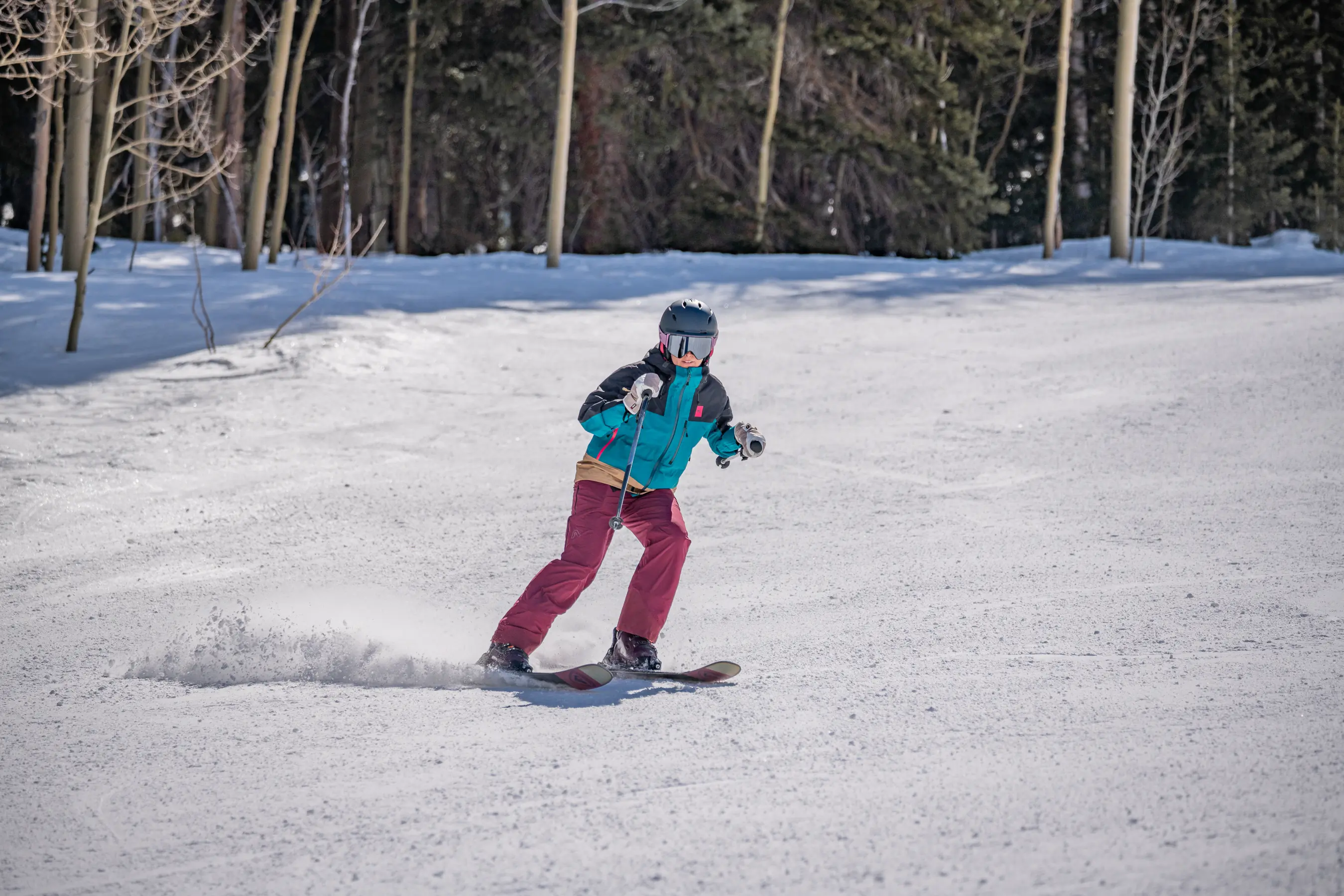



Waist Width
We suggest you get started on a pair of narrower all-mountain skis rather than wider or fat all-mountain skis or specialized pairs for the powder, backcountry, or race turns. All-mountain skis on the skinnier side are easier to control and help skiers learn their form on hardpack snow before they head to less-managed pockets around the ski area.
That said, the ideal width for a ski also boils down to personal preference and goals. Do you live in a place that regularly gets a refresh of deep snow? Are you only skiing on powder days? Then consider a slightly wider or wide ski. The waist width makes a big difference with how a ski handles powder. Wider skis equal greater overall volume and float through deep, soft snow.
- 85mm-95mm waist width: Can tackle both groomed and powder runs but excels on groomers
- 90mm-109mm waist width: Offers a more balanced approach through either powder or atop packed snow
- 100mm and higher waist width for women; 109mm or higher waist width for men: True powder skis that are surfy and floaty in powder. These will perform on groomers but generally won’t feel as agile in turns or easy to control at high speeds
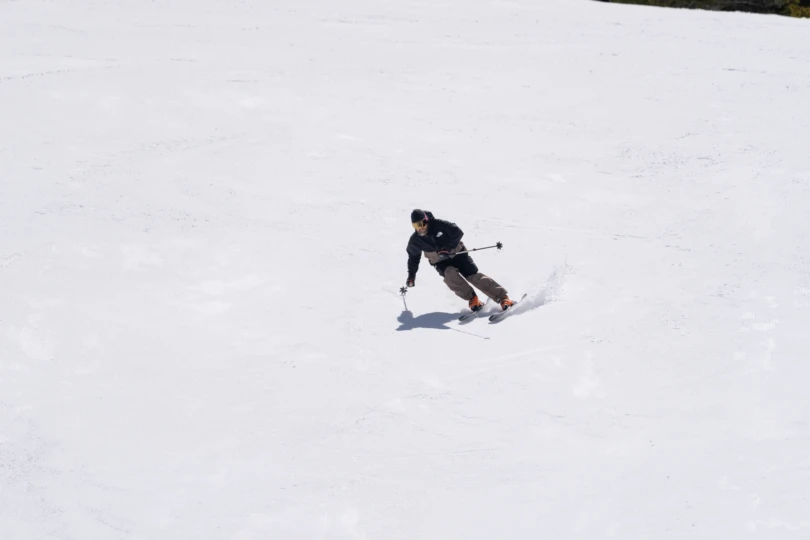



Ski Length
You’ll need to choose an adequate ski length, which is best done by looking at the manufacturer’s suggestions for the ideal height and weight for that ski size.
In general, a ski should reach between your chin and the top of your head when standing upright on the ground. Within that spectrum, a shorter ski will feel easier to turn, and that’s a good trait to start with as a newbie practicing technique.
Longer skis handle higher speeds better and also provide some extra volume for powdery laps, so those are typically preferred by more experienced resort-goers.
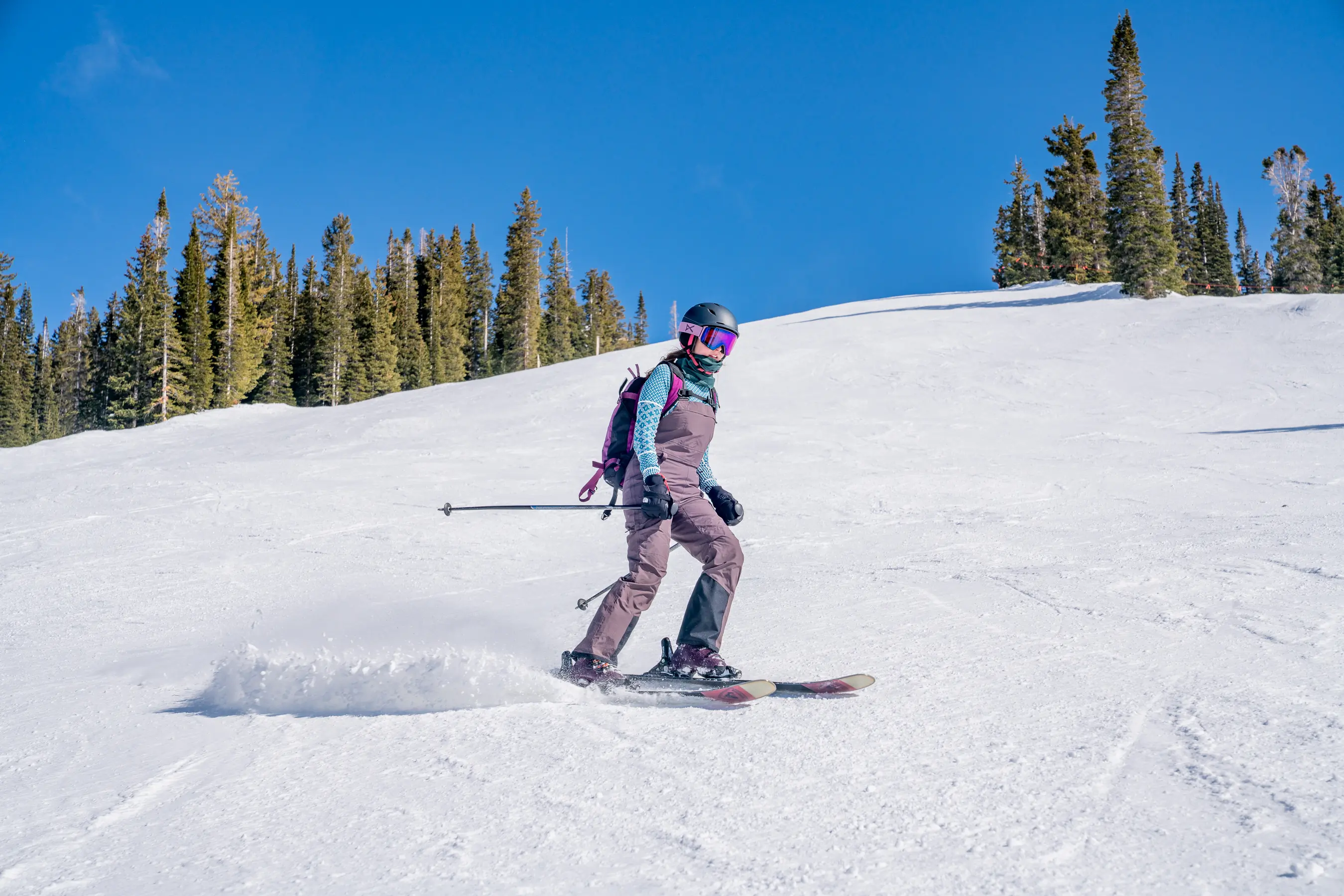



Ski Profile: Camber & Rocker
Pay attention to the profile of a ski. Camber is the traditional design, which creates a slight arc in the ski. When flat on the ground, the centermost part of the ski slightly bows off the surface of the snow. Camber equates to energy in a turn and a poppy feeling or strong feedback in the ski.
In more recent years, a bunch of all-mountain skis have been designed with a mix of the opposite shape, which is called rocker. Also known as reverse camber or early rise, a rocker shape is like an upturned banana sitting atop the snow, so the center of the ski hugs the ground while the tips or tail rise off the ground.
Sometimes the rocker is solely in the tips, while other designs have reverse camber in both the tips and tails. The degree and amount of rocker differ between each ski design, too. Rocker shapes offer increased maneuverability, a forgiving edge hold, and enhanced flotation in deep snow.
The majority of the all-mountain skis we highlight here are a hybrid of camber and rockered tips or tails. True traditional cambered skis work well on groomers, but tips with a rise can help make the ski feel more playful with less of a bite in the snowpack.
Ultimately, choosing the best profile comes down to personal preference, which is acquired with experience. A great way to try out different profile shapes is to test drive a few pairs during demo days at ski mountains, which are usually held throughout the season.
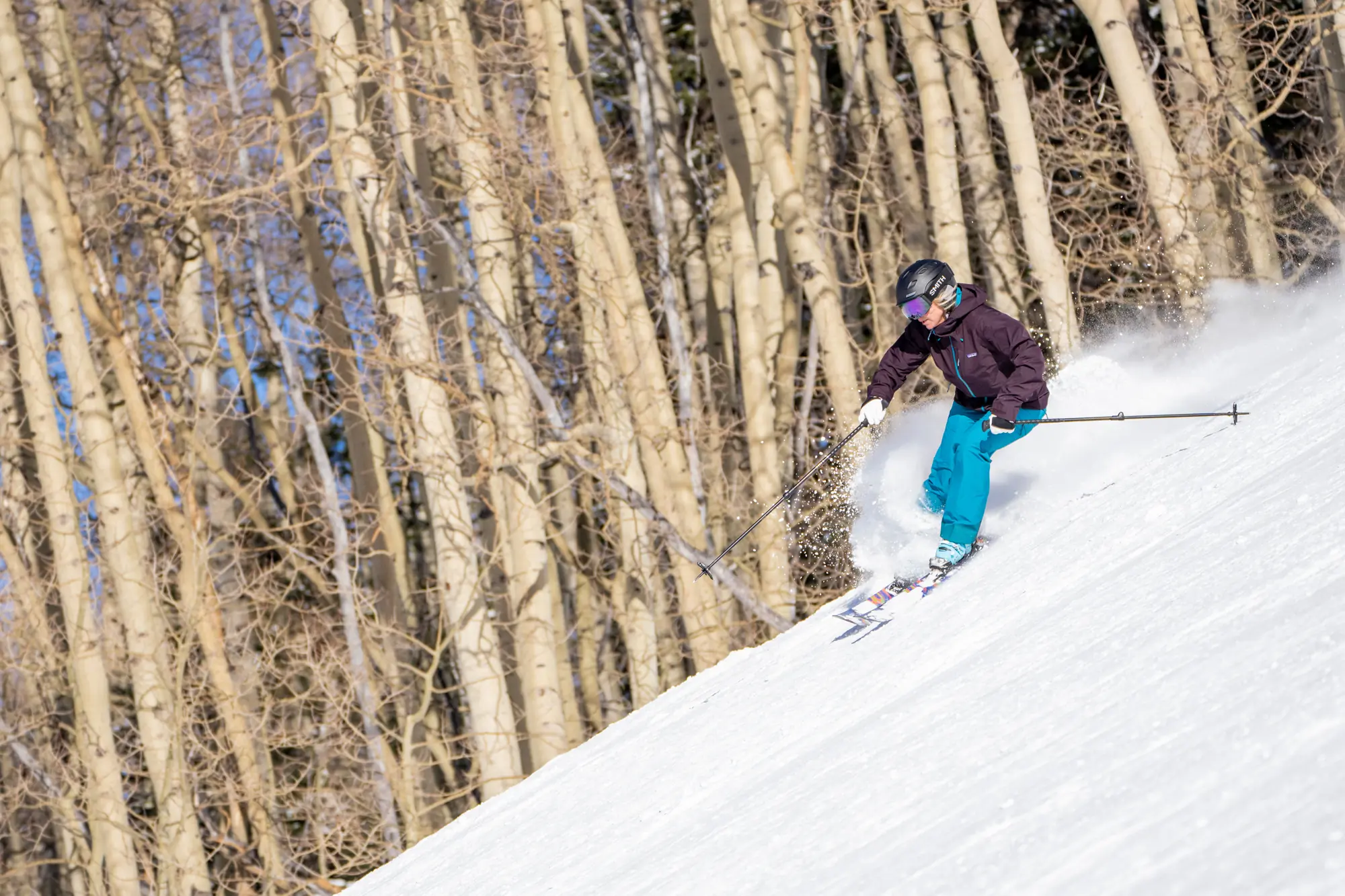



Stiffness & Flex
Softer skis are more flexible than their stiffer counterparts. They generally perform best in smooth terrain, at slower speeds, and are less aggressive in turns. Often, beginner skis are constructed with softer materials — usually a foam or composite core — that are more economic and not as difficult to control on the slope.
Stiffer and pricier skis integrate wood partially or fully into the core, and some add a layer of carbon material. Less malleable materials such as wood increase the durability and overall longevity of a ski. It won’t break down as quickly as a foam core and is a better choice for intermediate and advanced skiers who are skiing faster and across rougher terrain or with a more aggressive style.
A wood core provides a snappier sensation from turn to turn, a greater transfer of energy, and improved stability at bigger speeds.
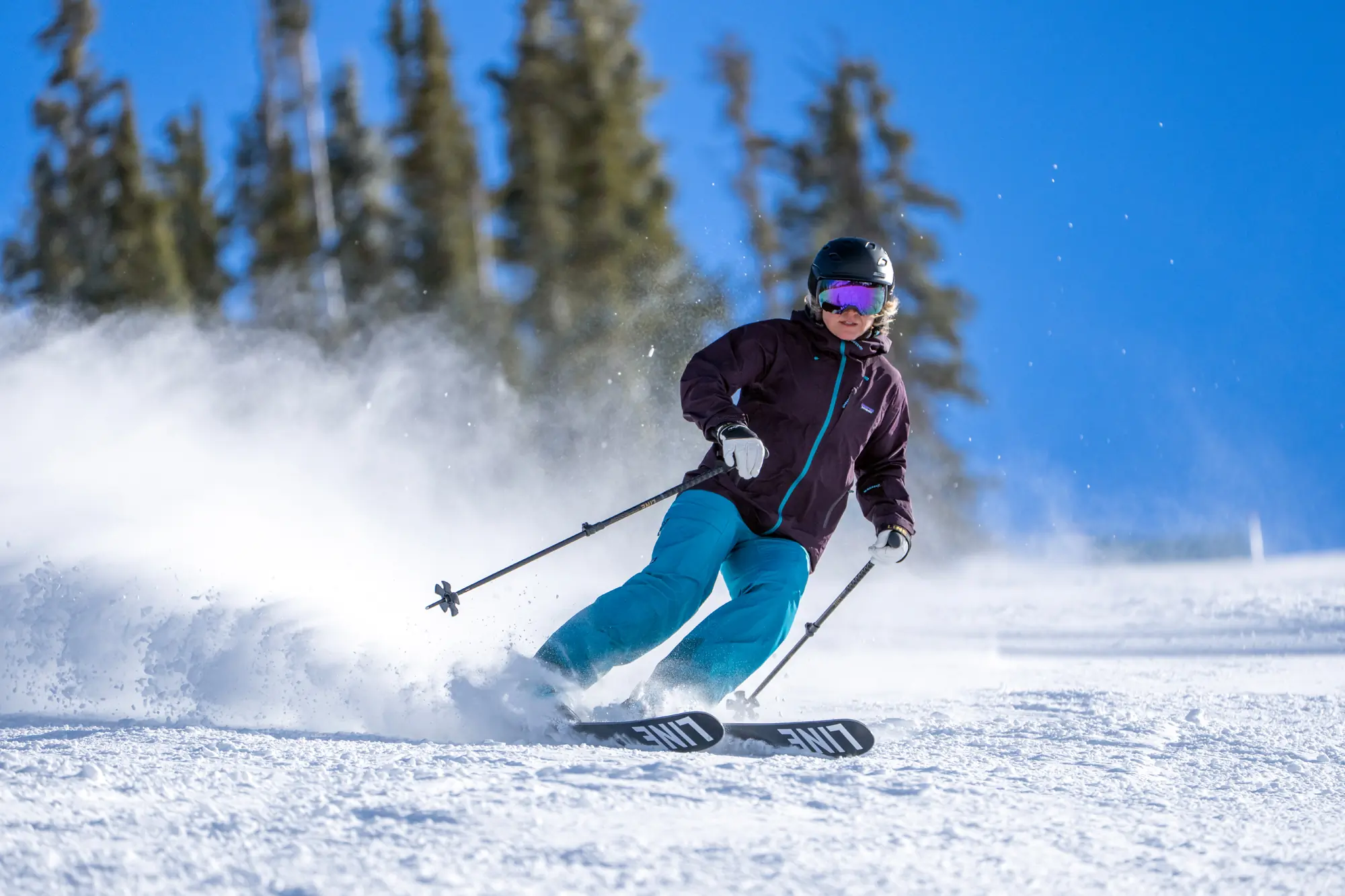



Sidecut & Turn Radius
The sidecut or turn radius of a ski indicates whether a ski excels at making tight turns or big, sweeping turns, which gain more speed on a slope. Skis with a low sidecut radius are better suited for tighter, shorter turns, which are ideal for beginners and skiers who want to maintain a low or moderate speed. We note the sidecut radius for each product listed in our guide.
The sidecut radius refers to the arc or the radius created by the dimensions of the tip, waist, and tail of the ski, if those edges were to extend to create a full circle. So, a longer ski length of the same ski will typically increase the turn radius, and the turn will feel less snappy.
If you look at each ski’s specific sidecut radius, you’ll notice short radius turns result from radius numbers in the low- to mid-teens, usually around 17 m. A radius of less than 15 m is optimal for carving hardpack slopes. A 15m-20m range is better suited for conditions all over the mountain.
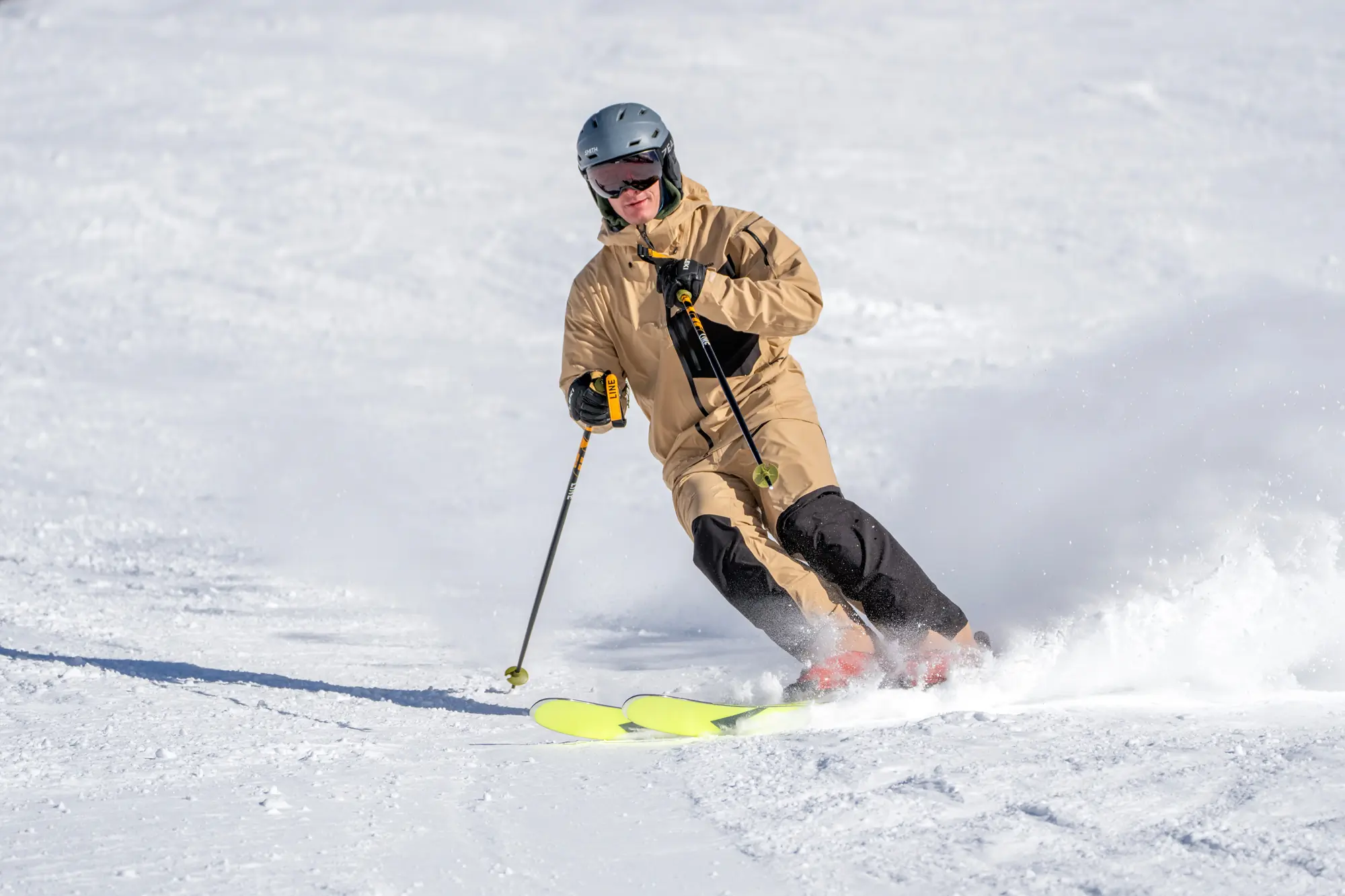



Materials & Construction
Ski manufacturers like to show off diagrams of the construction of their skis and describe the materials used in detail which can be intimidating if you, like most people, aren’t an expert in ski construction. Do you need to know the difference in flex characteristics between maple and paulownia woods to buy a pair of skis? Between titanal and titanium?
The answer, thankfully, is no. Knowing a few basics about how different materials affect how a ski handles can be helpful, but these are just clues and the reality of how the materials used to make a ski come together in your experience on them isn’t an equation you can feed into a computer. That said, here are some basics about common ski ingredients and what they might mean for a particular pair.
Metal
Steel, aluminum, and metal alloys such as titanal are often used to stiffen skis. Metal is heavy and a ski with a lot of metal can be harder for beginners to control. Metal dampens vibrations at speed and is employed to tamp down chattering when skiers get moving fast.
As a beginner, having some metal can smooth out your ride but look at ski weights to avoid heavy metal skis you won’t be able to drive easily. The Rossignol Men’s Experience 76 has 100% recycled steel edges.
Wood
Despite all the advancements in ski tech, wood is still the main ingredient in most skis’ cores. Poplar and paulownia are popular lightweight softwoods for beginner-oriented skis that deliver long-lasting energetic flex to a ski without weighing it down.
Hardwoods such as ash, beech, and maple are stiffer and less common in beginner skis. Many manufacturers combine wood with many other materials to create a certain feel, so don’t overthink which tree went into your skis. For instance, the Elan Women’s Wildcat 76 has a laminated wood core that is responsive and durable.
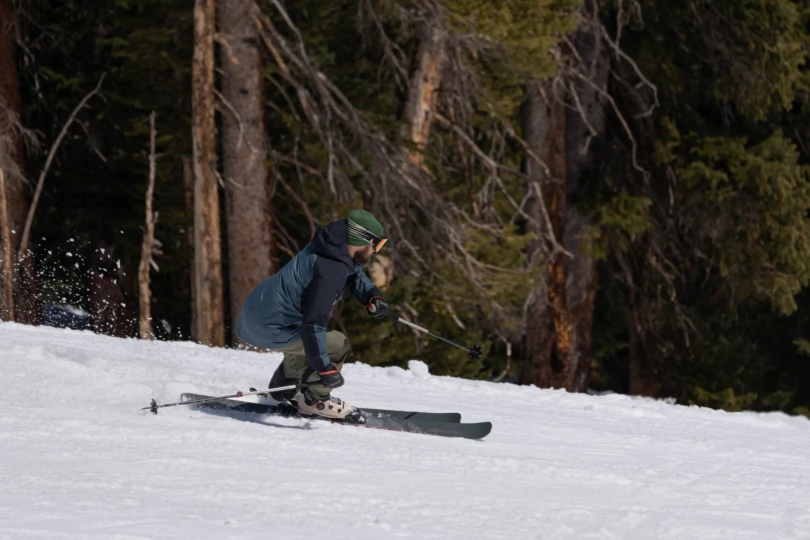



Foam
Foam is one of the few alternatives to wood when it comes to a ski’s core. The performance characteristics of foam are not great and it’s only a primary ingredient in cheaper skis. Foam core skis are light but highly prone to chattering and they don’t last. You can save money, but you’re usually better off renting a wood-core ski and buying when you’re ready.
Carbon
Carbon is expensive and is used in sheets and strips to provide lightweight stiffness, often in place of metal. Most beginner skis are more budget-oriented and skip carbon altogether but having some carbon in your skis can provide some stiffness without making your skis too heavy.
Skis that use a large percentage of carbon in their builds are often aimed at backcountry skiers and require experience to ski confidently. The Elan Men’s Wingman 78 C incorporates a layer of carbon.
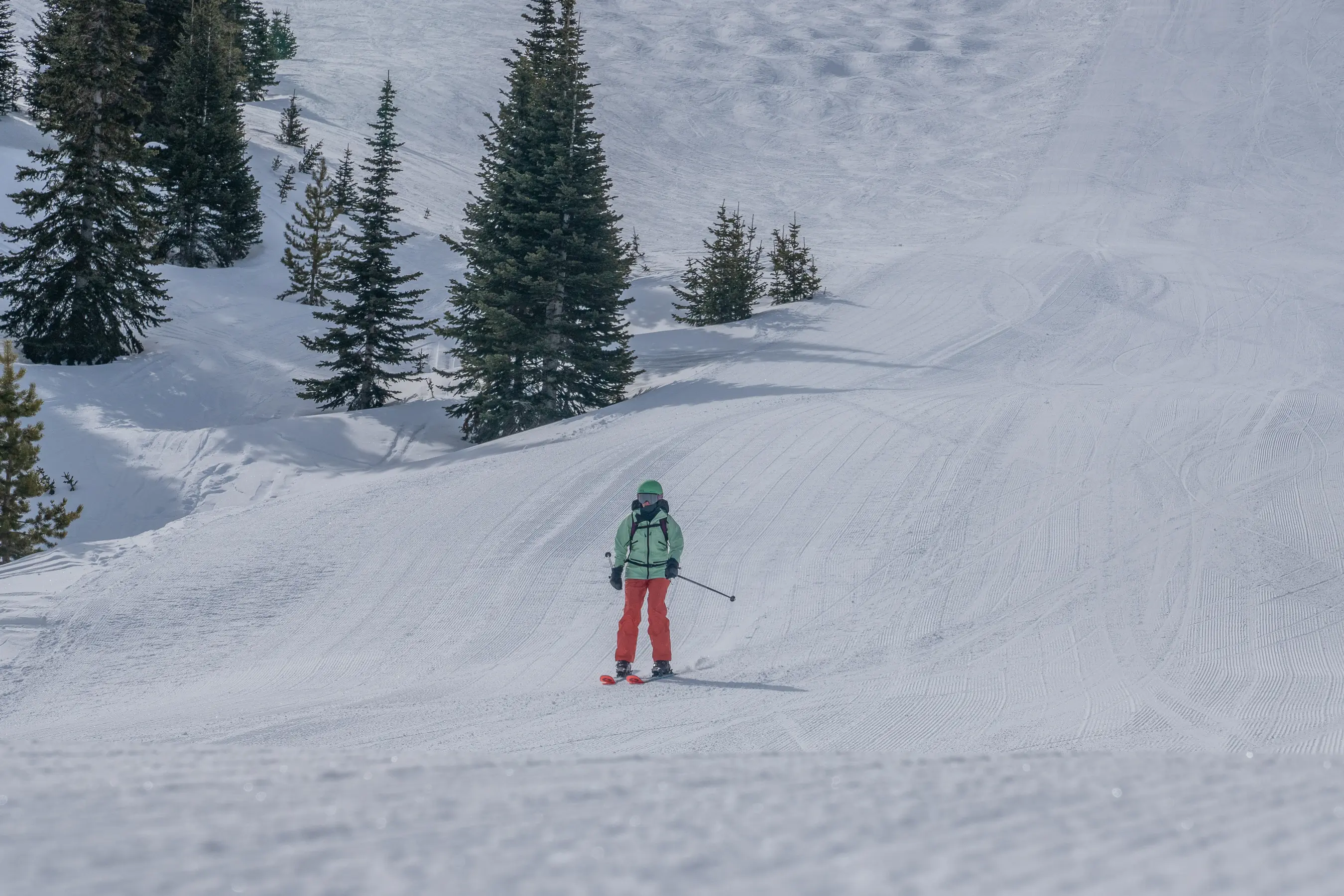



Rentals & Demos
If you’ve read this far and still aren’t confident in making a decision, “try before you buy” is a great way to find a pair you love. Most beginning skiers start out on renting gear at the base area which, depending on the quality and condition of the rental fleet and knowledge of the staff, may or may not give you a good starting point.
Those who’ve been let down by the on-mountain rental experience should look for an independent ski shop that offers rentals and call or visit them outside of the morning and afternoon crush of other renters. A knowledgeable staffer should be able to ask the right questions to direct you to skis you should like. If you’re interested in skis outside of their rental fleet, ask if they have demo skis (retail skis with adjustable bindings) of the models you’re interested in.
Another option is “demo days.” Many ski brands will set up tents at popular ski resort base areas with a fleet of demo skis that you can try for free for a few runs. Check your ski area’s events calendar or the website of a particular brand you’re hoping to test to see if they’re conducting demo days in your area.
Some ski shops will offer season-long rentals that are usually significantly cheaper than buying your own skis and bindings and offer good value if you plan on skiing frequently. Buying your own setup will save you money in the long run, but this is a good option if you’re not ready to commit to a specific pair.
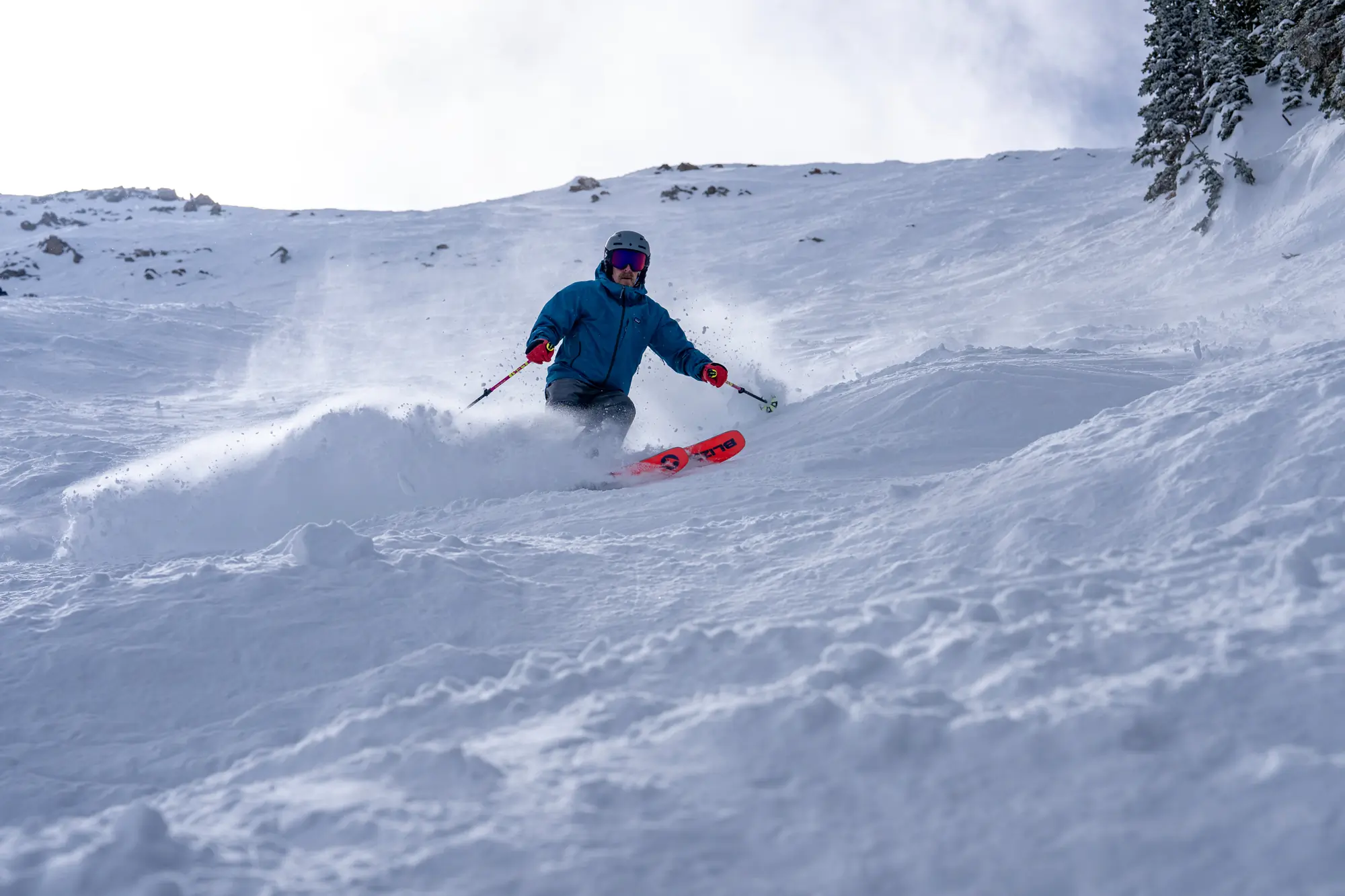



Price & Value
This collection of our favorite beginner-supportive all-mountain skis range in price from $450 to $729. In contrast, the skis in our Best All-Mountain Skis guide for intermediate, advanced, and expert skiers range from $650 to $1,549 with a typical price in the $700 range — but none of those skis include bindings. Our Best Women’s All-Mountain Skis guide spotlights skis that typically fall in the $700-800 range, give or take.
Often these types of skis are pre-paired with bindings, too, which creates more value for newcomers to the resort. The option of purchasing a bundled product removes the responsibility and time of learning about and hunting down a good ski binding as a beginner.
Typically, the bundle will include bindings that have not been mounted: You’ll still need to take your new skis and bindings to a professional at a local ski shop to properly mount the bindings with your ski boots.
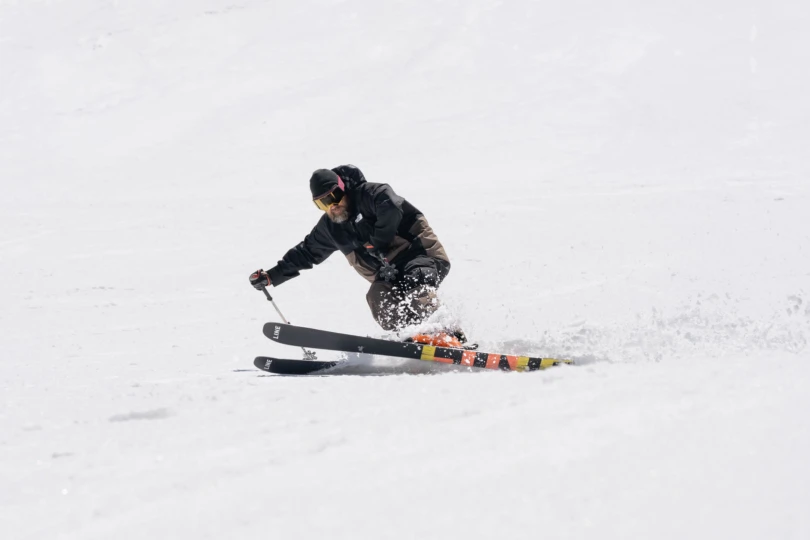



Budget
Beginner all-mountain skis carry entry-level price tags due to the materials and construction that are easier to control, which helps new skiers hone their skills. Overall, the designs of these skis are friendlier on the hill. For example, the edges are not as grabby, the stiffness and rebound is not as high, and the turn radius is not as aggressive.
In most cases, the quality of the materials is not as top-notch, which is OK, because the athlete, terrain choices, and snow conditions are typically not putting as much pressure on the ingredients. One example is the K2 Men’s Mindbender 85 ($450).
Mid-Tier
Stepping up, you’ll see more pieces and technology loaded into the skis. Like the Elan Men’s Wingman 78 C and Women’s Wildcat 76 ($600), which have included bindings plus the brand’s proprietary Amphibio technology in the profile, meaning the outermost edge of the ski is rockered upward, and the interior edge is a traditional camber.
Premium
At the higher end of our beginner skis, we’ve selected designs like the Icelantic Men’s Pioneer 86 and Women’s Riveter 85 ($729), which are easier to drive but are more of an intermediate-level ski due to the strength and power needed to drive them. But as a boutique option, this is the most playful and forgiving pair from the brand, and they’re fun to ski to hop on if you tend to progress quickly.
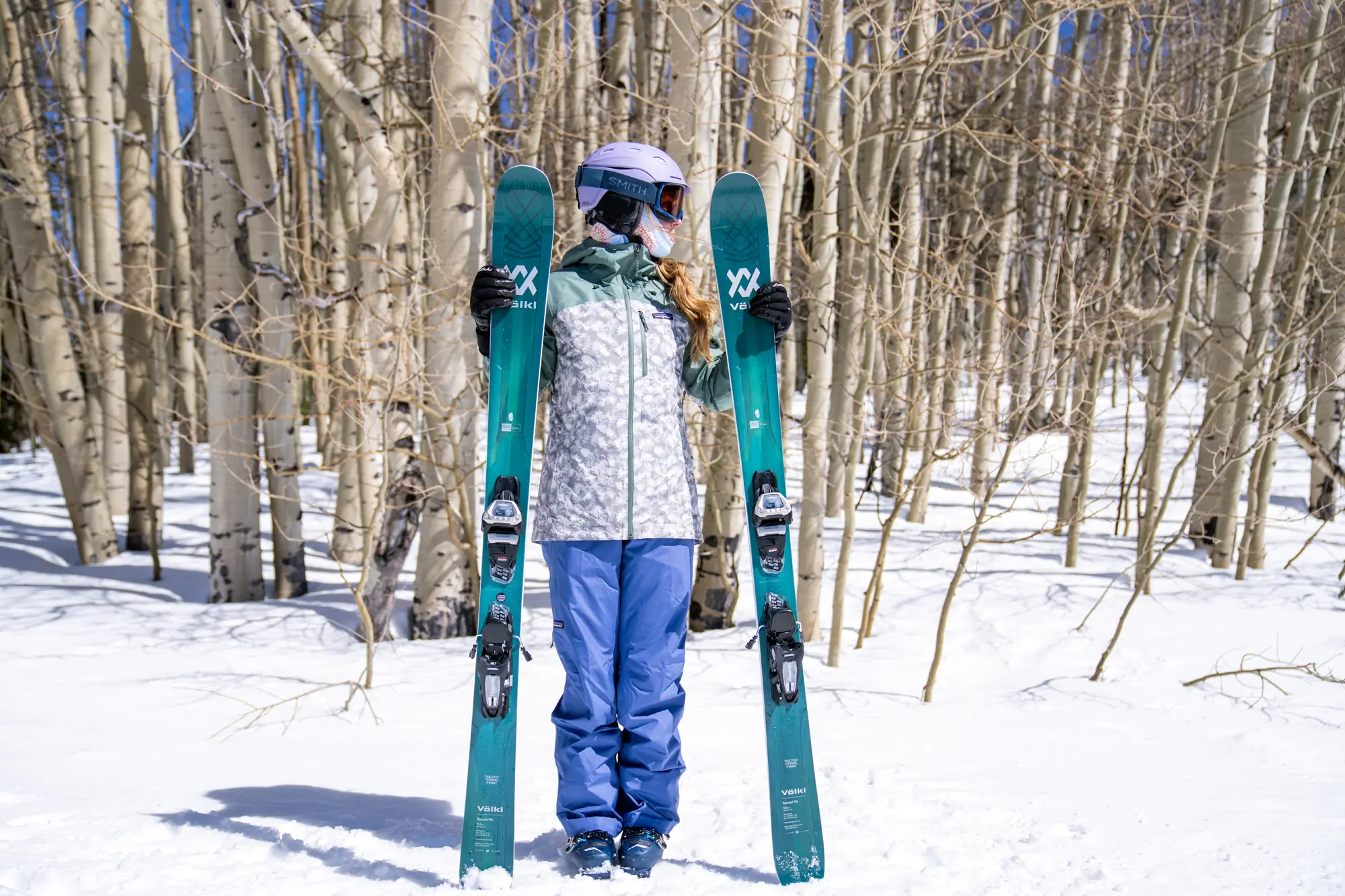



Frequently Asked Questions
Many ski brands build skis that are tailored to beginners. Beginner-centric skis have several qualities in common.
A ski binding is often conveniently included in the bundle. Beginner skis also cost less than top-tier designs. That budget price tag is a reflection of materials in the construction that are not as premium or durable for aggressive, high-volume use. Budget skis are still well-made but are developed to match a certain environment and user.
Also, the widths from the tip to waist to tail are typically narrower. Extra volume isn’t key for skiers who need to stick to the consistent hardpack. And groomed runs are the best place to learn your foundation and gain ski muscle.
Start by checking with the ski manufacturer regarding a recommended size for your height and weight. Each ski has its own flex rating, and taking skier mass into account is helpful for pairing skiers with the correct size.
Shorter skis are more maneuverable than their longer counterparts. A shorter ski supports faster turns versus the long, speed-inducing turns achieved with longer skis and experienced skiers. Longer skis also add more volume underfoot and cut powder more easily, so they’re a good choice for floating in deep snow.
All-mountain skis are generally able to handle a mix of groomed runs and powder, but each design has a greater affinity for one or the other. If you ski groomed runs most of the time, it’s a good idea to invest in a ski that complements the experience of carving hardpack snow and managing higher speeds. You’ll still be able to ski in powder with said design, but it won’t feel as effortless.
The waist width, ski length, and profile shape make the biggest difference with how a ski handles powder. Wider equals greater overall volume and float through powder. Skis with an 85-95mm waist can tackle both groomed and powder runs but excel on groomers. Wider designs with a 90-109mm waist offer a more balanced approach through either powder or atop packed snow.
True powder skis are really surfy and buttery in powder: 100 mm or higher for women, or 109 mm and greater for men. These will still perform on groomers, but they generally won’t feel as easy and nimble to control at high speeds or agile in quick turns.
Longer skis likewise add volume beneath a skier, which helps with float. That said, check out the manufacturer’s suggestions for the ideal weight and height for that ski size, which we don’t recommend you exceed.
Profile shape can also enhance maneuverability and hover in powder via fully rockered designs or rockered tips and tails, otherwise known as early rise or reverse camber. Though these terms are used across various skis created by different brands, the precise amount of rise is unique and can feel subtly different between each design.
After a day on the hill, it’s a good idea to dry off your skis. To maintain the edges, you can smooth out the burrs — small nicks in the metal — with a pocket stone. After a few days of use, and especially after abuse on hardpack snow, you can replenish the hot wax.
Choose a wax for the current snow conditions and temperatures you’re skiing in. It’s a good idea to invest in a ski wax iron, which is specifically designed for waxing skis, so the temperature is more controllable and doesn’t get too hot for your ski’s base.
At least once a season, it’s really nice to get your skis tuned up by a professional tuner at a local ski shop, which will confidently know and have the equipment to tune and sharpen the edges, perform a base grind, repair gouges in the base, and apply a robust wax.
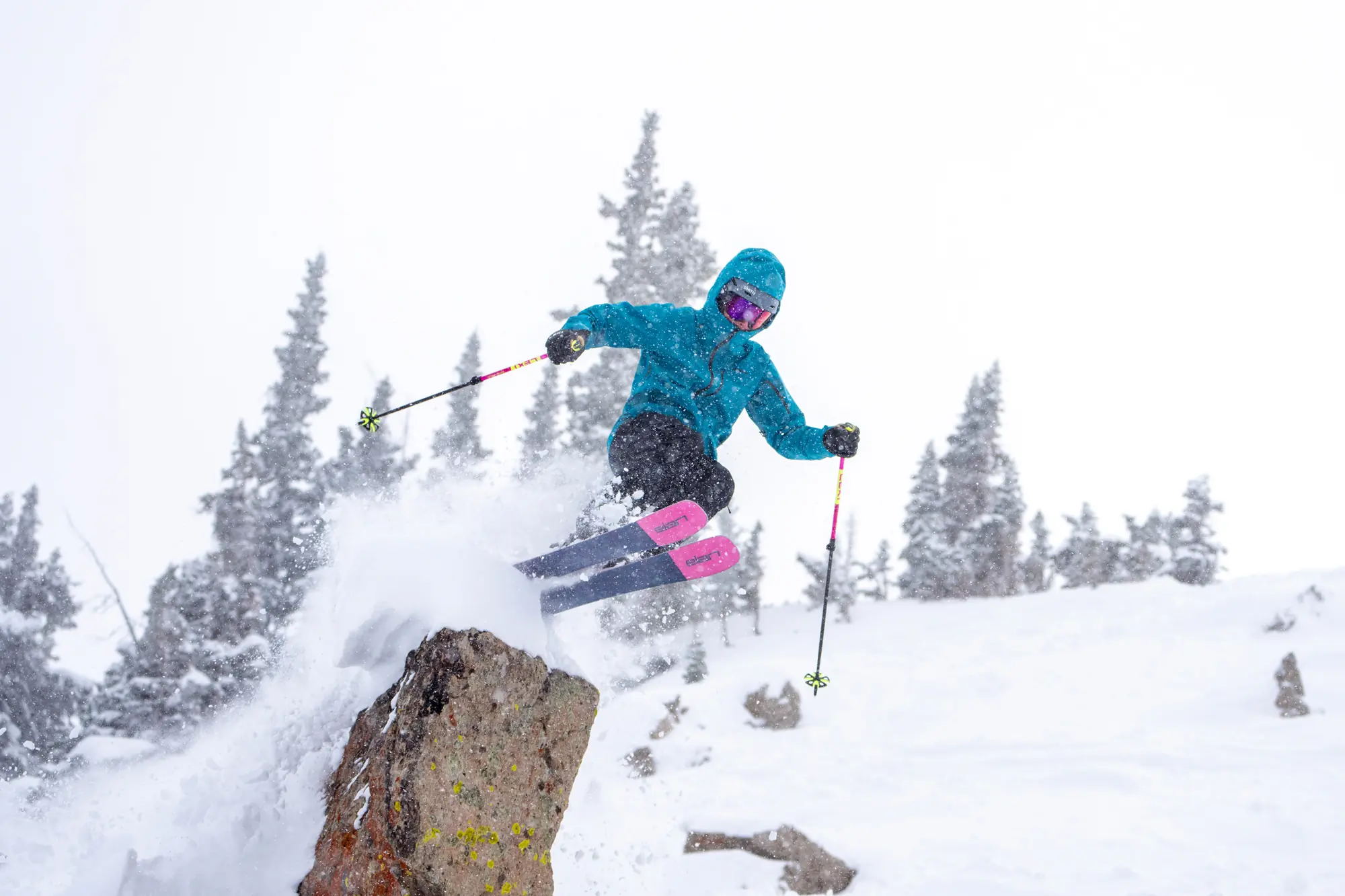

The Best All-Mountain Skis of 2025-2026
The right ski can make your day, and not every all-mountain ski is created equal. We hit the slopes and put them to the test from Vermont to Colorado to find the best options.
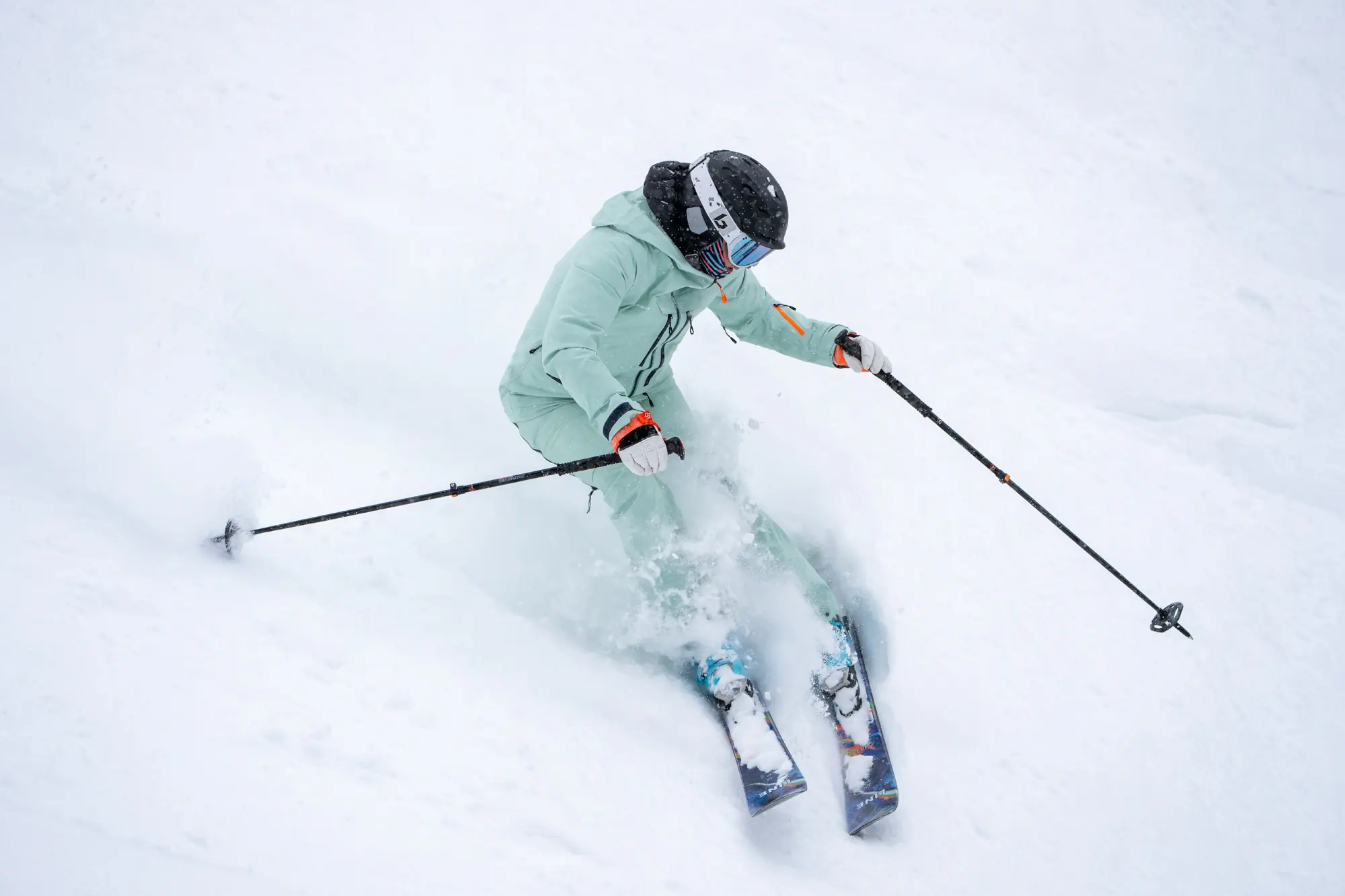

Line 172 Women’s Pandora 104 Ski Review: A Confidence-Building All-Mountain Ski
The freshest version of this all-mountain ski sets a high bar among women’s-specific designs for a wide spectrum of conditions and terrain.
